Navigation
Workspace app is the new name for Receiver. This post applies to all Workspace app versions, including the Current Release version 2409.10 and the LTSR version 2402 CU3.
- Change Log
- Workspace app versions
- Overview
- Uninstall Old Workspace app Clients
- Installation and Configuration
- Workspace app ADMX GPO Template
- Pass-through Authentication
- Automatically add StoreFront Accounts to Workspace app
- Control Shortcut placement on Desktop and Start Menu – and Workspace Control (Session Reconnect)
- Enable Prelaunch
- Control Device Mapping Prompts
- Desktop Lock
- Use Studio to configure Workspace app Accounts in Published Desktop
- Published Desktop – configure Workspace app to place shortcuts
- Script / Automate Workspace app Self-Service
- Microsoft Teams
- Troubleshoot:
💡 = Recently Updated
Change Log
- 2025 Jan 16 – updated article for Workspace app 2409.10
- 2025 April 2 – Versions – updated for Workspace app 2402 LTSR Cumulative Update 3
- GPO Settings – SSO in Win11 24H2 requires Enable MPR notifications for the System; Desktop Viewer Toolbar Options
- Registry Values – Remember USB connections
- 2023 Nov 15 – Global App Configuration Service is now available to all on-premises customers even if no Citrix Cloud entitlement.
- 2023 May 4 – Pass-through Authentication – added GPO setting Enable MPR notifications for the System
- 2023 Mar 22 – updated article for Workspace app 2303; anti-dll injection GPO setting
- 2022 Dec 19 – updated article for Workspace app 2212; app protection GPO setting
- 2022 Nov 4 – Versions – updated for Workspace app 1912 LTSR Cumulative Update 7 Hotfix 2
Workspace app Versions
Citrix Workspace app uses a YYMM (year/month) versioning format, of which version 2409.10 (24.9.10.28) is the newest Current Release. See Citrix Docs for the list of new features, some of which only apply to Citrix Cloud.
Workspace app 2311 and newer have a new installer interface.

Workspace app 2303 and newer automatically install the App protection components with an option to start them after installation. Older Workspace apps have an option to install App protection and if you don’t select this and later want App protection then you must uninstall Workspace app and reinstall it.

- See App Protection at Citrix Docs to enable App protection for the authentication screen. Workspace app 2305.1 and newer automatically start it for authentication if you have selected the Start App Protection check box during installation.

The newest Current Release version of Workspace app is version 2409.10.
The newest LTSR (Long Term Service Release) version of Workspace app is version 2402 Cumulative Update 3.
Workspace app Modules
The Workspace app installer deploys multiple modules. Here are the important ones:
- ICA Engine (wfica.exe) – process that uses the ICA protocol to connect to published apps and desktops.
- Self-Service (selfservice.exe) – gets icons from StoreFront and displays them in a Window. When an icon is clicked, Self-service passes the ICA file to the ICA Engine to establish a connection.
- Single Sign-on (SSON) for ICA (ssonsvr.exe) – captures user credentials and submits them to VDAs after an ICA connection is established
- Workspace Auto-Update (CitrixReceiverUpdater.exe) – Notifies users of Workspace app updates. The most recent name for this component is Citrix Workspace Update.
Custom ICA files are no longer supported. However, Ryan Butler has created a script that asks StoreFront for an ICA file. Explicit credentials are supported. Find the script at Github.
Workspace app Discovery and Beacon Process
If you are using Workspace app’s built-in user interface (instead of a web browser), then Workspace app first prompts you to perform discovery, which is also called Add Account.
Workspace app will contact the FQDN and request download of the StoreFront Provisioning File.
- If you entered a StoreFront FQDN, then Workspace app will download the Provisioning File directly from the StoreFront server.
- If you entered a Gateway FQDN, then Gateway will first prompt the user to authenticate. After authentication, Gateway will connect to its configured Account Services address, and download the Provisioning File from StoreFront. The Account Services address is configured in the NetScaler Gateway Session Profile on the Published Applications tab.
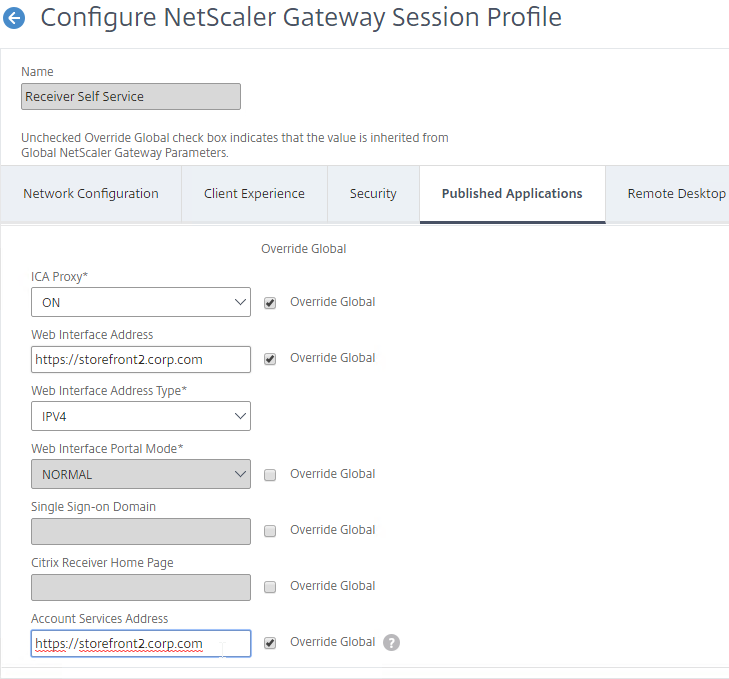
If your StoreFront server is configured with multiple stores, then the user will be prompted to select a store. Unfortunately, there’s no configuration option in NetScaler Gateway to force a particular store.
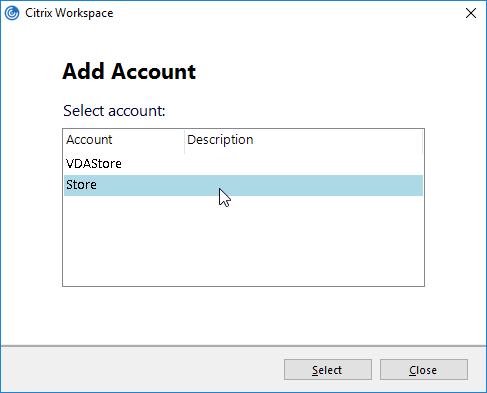
- One workaround is to hide the store that you don’t want visible externally. See How to configure Receiver to a Store that is not advertised for special syntax.
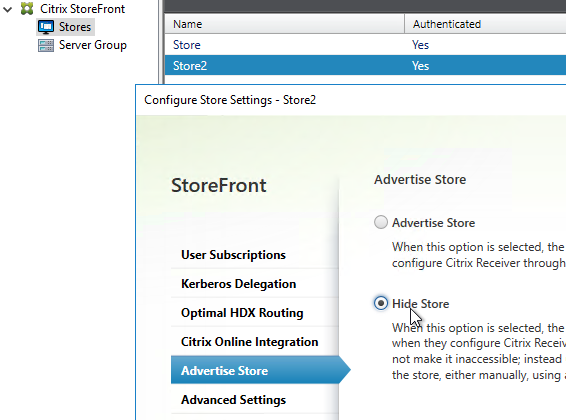
The Provisioning File downloaded from StoreFront is an XML document containing values for several items configured in the StoreFront console. You can export the Provisioning File from the StoreFront console by right-clicking a Store.
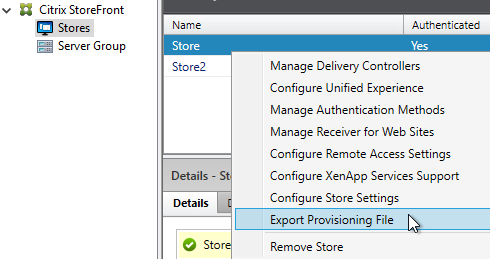
The ReceiverConfig.cr Provisioning File looks something like this:

Here are the values in the Provisioning File:
- Address – the Base URL configured in StoreFront Console
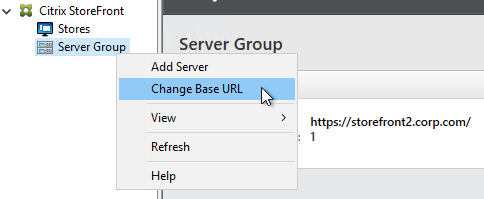
- Internal Beacon – as configured in StoreFront Console. This can be the Base URL, or a manually specified URL.
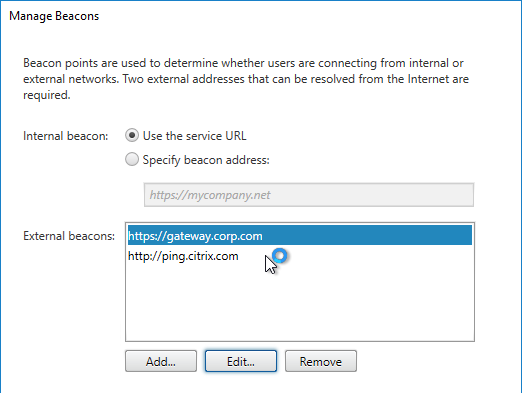
- External Beacons – as configured in StoreFront Console
- Gateways – as configured in StoreFront Console. If there are multiple Gateways, when enabling Remote Access on the Store, then only one Gateway is selected as Default
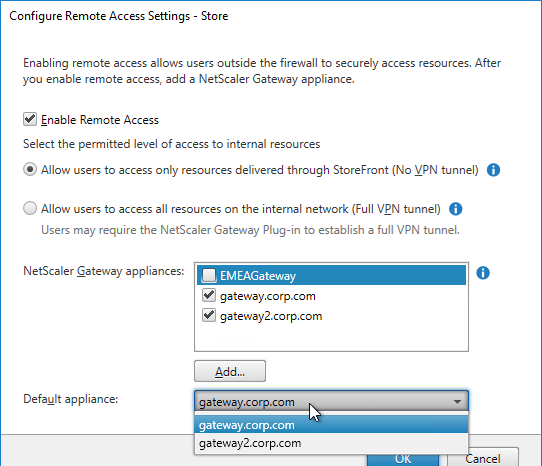
- SRID – Store ID. An important value to consider for multi-datacenter configurations. The SRID is set when the Store is created. It can also be changed by editing C:\inetpub\wwwroot\Citrix\Roaming\web.config.
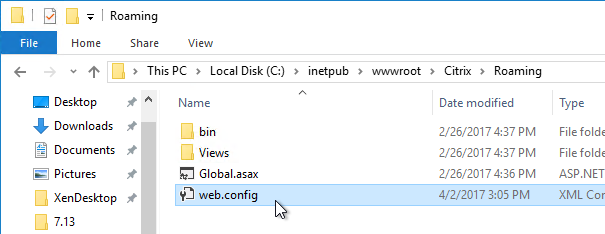
Workspace app reads the Provisioning File, and configures itself by inserting the file’s contents into the user’s registry. The values are located under HKCU\Software\Citrix\Dazzle\Sites and HKCU\Software\Citrix\Receiver\SR. If you performed discovery through NetScaler Gateway, notice that the internal Base URL is added to the user’s registry.
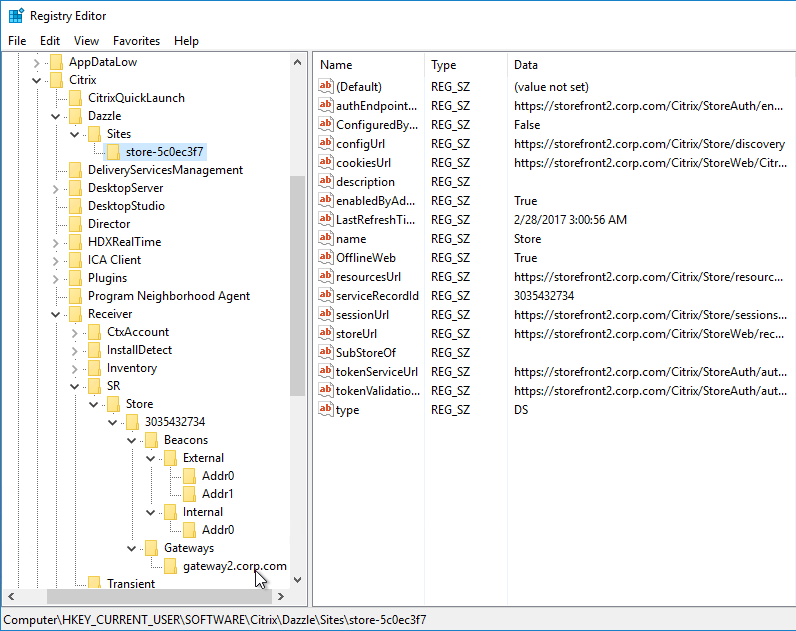
Once Workspace app is configured, it then performs the following steps:
- Attempt to connect to the Internal Beacon.
- If the Internal Beacon is reachable, connect directly to the StoreFront Base URL (Address).
- If the Internal Beacon is not reachable:
- Attempt to connect to the External Beacons. If the External Beacons are not reachable, then stop attempting to connect.
- Connect to the Gateway address configured in the Provisioning File. If there is more than one Gateway, connect to the Gateway that is marked as the Default.
Here are some interesting notes on this connection process:
- The FQDN you entered during Discovery has absolutely nothing to do with how Workspace app connects to StoreFront or Gateway. The actual connection process is controlled by the contents of the Provisioning File, not the Discovery address.
- If the Provisioning File has multiple Gateways defined, Workspace app uses whichever Gateway is marked as Default. Workspace app completely ignores whatever Gateway FQDN you entered during Discovery. To use a non-default Gateway, the user must manually select the other Gateway in Workspace app’s Advanced Preferences.
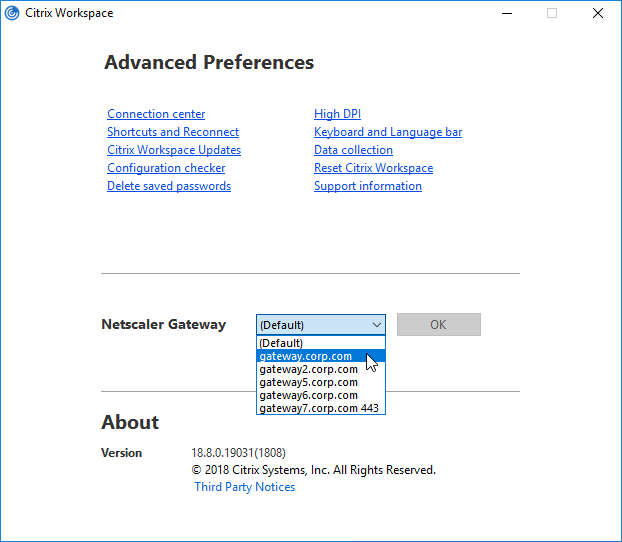
In StoreFront Console, if any configuration changes are performed that affect the Provisioning File, it takes an hour for Workspace apps to reconfigure themselves automatically. Or users can remove Accounts and re-add (or Reset Citrix Workspace) so that the updated Provisioning File is imported.
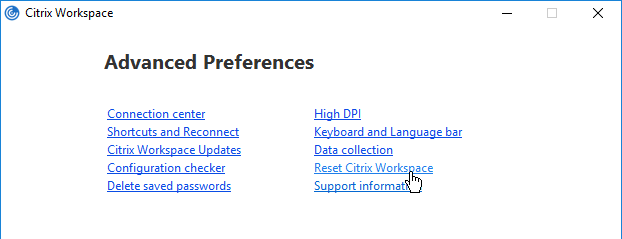
Here are some additional methods of performing Workspace app Discovery:
- After exporting the Provisioning File from StoreFront Console, distribute it to users, and ask them to double-click it.
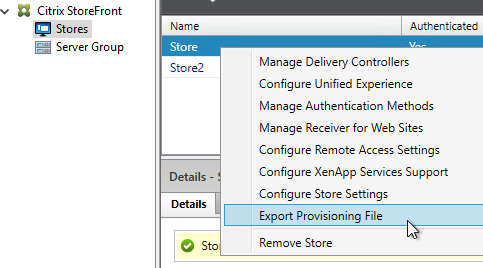
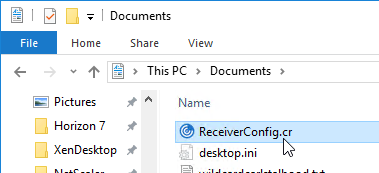
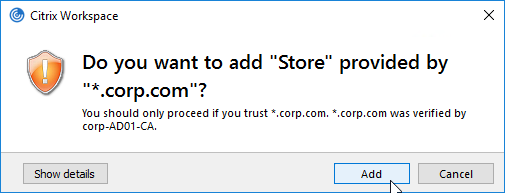
- After logging in to Receiver for Web (StoreFront), at the top right, click the username, and click Activate. This downloads the receiverconfig.cr file, which is identical to the one you can export from StoreFront Console. The user then must run the downloaded file.


Virtual Monitors
In Workspace app 1812 and newer, when connected to a published desktop on a single monitor, you can split the screen into virtual monitors. This feature is intended for large 4K monitors.
- In the desktop toolbar at the top of the screen, click Preferences.

- Switch to the Monitor Layout tab.
- On the bottom, select Horizontal or Vertical, then click somewhere in the blue box to draw a line. The single monitor will be split along this line. You can set different DPI for each portion of the virtual display.
- Right-clicking one of the split sections changes that section to the primary display.
- Click OK when done.
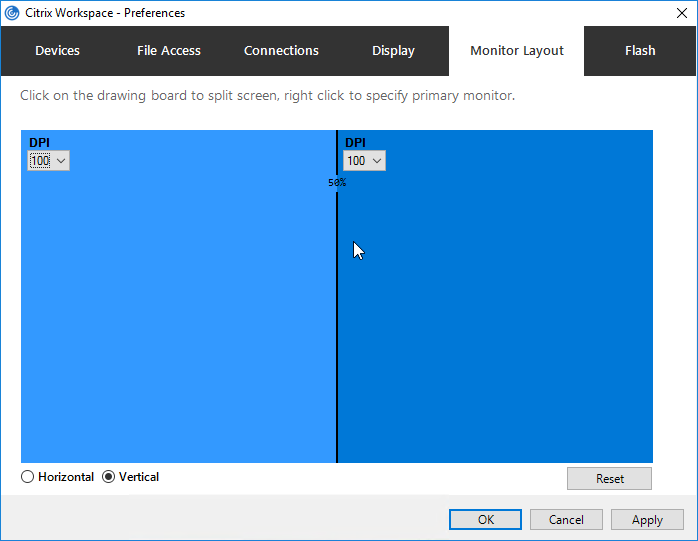
- In the toolbar, click Window to resize it to a window, and then click Full Screen to cause your virtual monitor configuration to take effect.
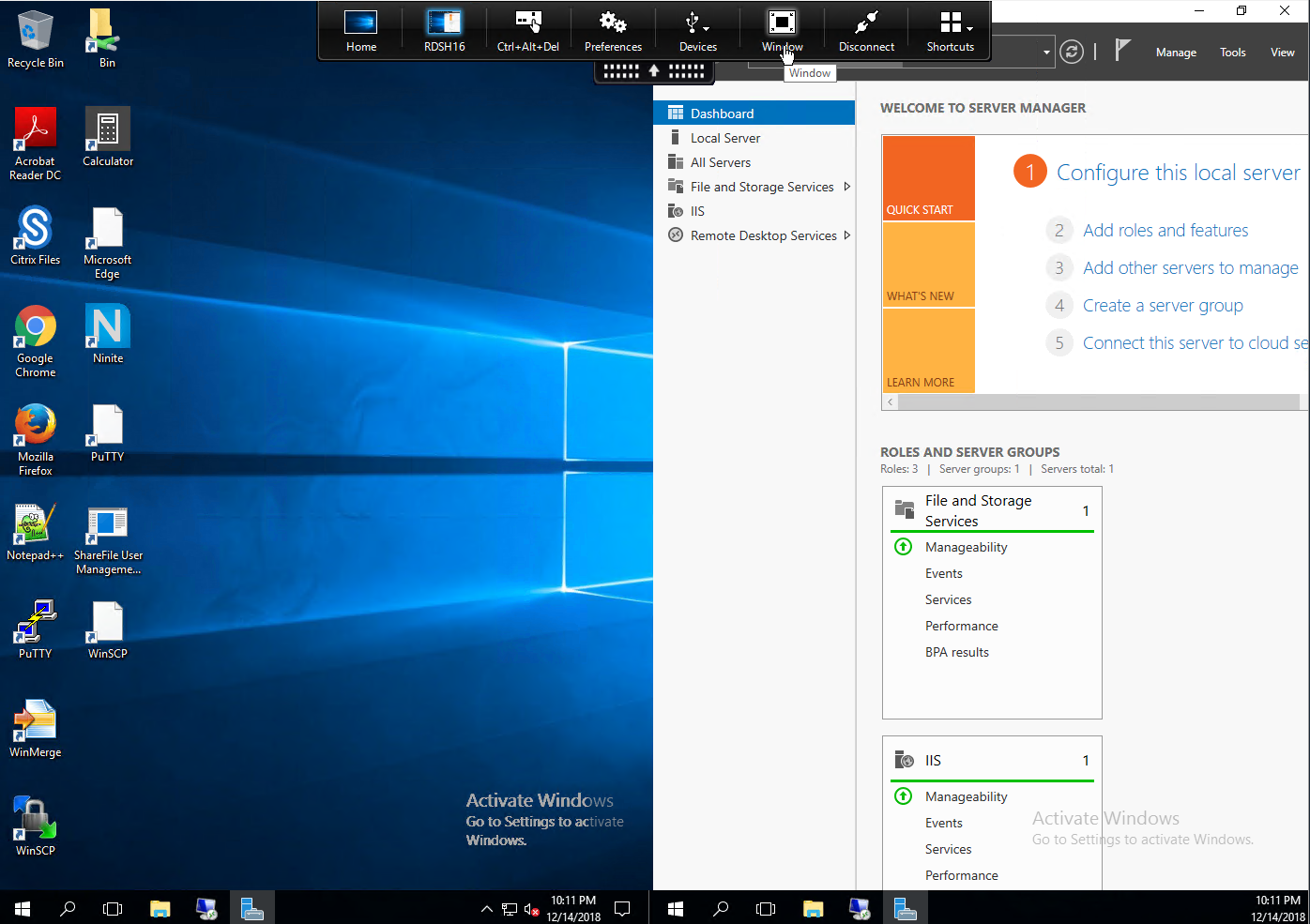
Uninstall Old Clients
Workspace app installer can do a force uninstall of old clients before installing the new version:
- In Workspace app 2309 and newer, run CitrixWorkspaceApp.exe /CleanInstall /Silent
- In Workspace app 1909 and newer, run CitrixWorkspaceApp.exe /ForceInstall /Silent.
- In Workspace app 1908 and older (including Receiver), run CitrixWorkspaceApp.exe /RCU /Silent or CitrixReceiver.exe /RCU /Silent.
Citrix CTX325140: How to Remove Client Files Remaining on System after Uninstalling Receiver for Windows.
Installation and Configuration
Administrator privileges – Administrator privileges are required to install any missing prerequisites.
Internet required – Recent versions of Workspace app download and install Microsoft Edge WebView2 Runtime, .NET Desktop Runtime 6.0.20, .NET Framework 4.8, and Visual C++. Internet access is required for the Workspace app installer to download these install files. Or there’s an Offline Installer for Workspace app 2309 and newer.

.NET Desktop Runtime 6.0.20 – Workspace app 2309 and newer will install x86 .NET Desktop Runtime 6.0.20 if it’s not already installed.

This section contains a summary of all common command line switches, registry keys, and policy settings for Workspace app.
Links:
- Citrix Blog Post: Optimizing Citrix Receiver for Pre-launch and Single Sign-On
- Citrix CTX202002 How To Deploy Citrix Receiver for Windows Using SCCM 2012 R2
Workspace app 2203 LTSR CU2 and Workspace app 2212 and newer fix security vulnerabilities.
CitrixWorkspaceApp.exe current release version 2409.10 or LTSR version 2402 CU3 can be installed by simply double-clicking it.
- LTSR Workspace app does not support Browser Content Redirection.
- Workspace app 2006 and newer do not support Windows 7.
- Workspace app 2206 and newer enable DPI Matching by default. DPI Matching can be disabled through client-side group policy, or in the Advanced Preferences in Workspace app 2212 and newer. DPI Matching prevents connections to CVAD 7.15. Multi-session VDAs with version 1912, by default, have DPI Matching disabled, but can be enabled in the VDA’s registry. See CTX460068 for details.
- Workspace app 2311 and newer have a new interface for installation.


- Workspace app 2402 and newer ask if you want to install the Microsoft Teams VDI Plugin or not. This is for Teams 2.1 and newer.



Administrator vs non-administrator
- Non-administrator – If a non-administrator installs Workspace app, then each non-administrator that logs in to the same workstation will have to reinstall Workspace app.
- Non-administrator installations are installed to %USERPROFILE%\AppData\Local\Citrix\ICA Client for each user.
- Administrator – If CitrixWorkspaceApp.exe is installed using an administrator account. then the Workspace app only needs to be installed once.
- Administrator installations are installed to C:\Program Files (x86)\Citrix\ICA Client.
- Administrator installations of Workspace app 1912 and newer can be manually upgraded by non-administrators by clicking Check for Updates. Older versions cannot be upgraded by non-administrators.
- Conflicts – If an administrator install of Workspace app is performed on a machine that has non-administrator installs of Workspace app, then the two installations will conflict. Best option is to uninstall non-admin Workspace app and Receiver before installing admin Workspace app. Otherwise, the user’s profile probably has to be reset before Workspace app is functional again.
- Citrix article CTX249920 Workspace App for Windows – Your apps are not available at this time – Issue when installing Citrix Receiver in not elevated/per-user install mode describes the HKEY_CURRENT_USER registry keys that must be deleted to fix this issue.
- For a script to clean-up the per-user installs, see Mark DePalma at Citrix Receiver Per-User Install Cleanup.
Global App Configuration Service
Global App Configuration Service (GACS) is a Citrix Cloud service that can push configurations to Workspace app clients. This Citrix Cloud service is now available to all on-premises customers even if you don’t own any Citrix Cloud entitlements.
- Login to https://citrix.cloud.com. If you don’t have a Citrix Cloud account, then login using your Citrix.com account credentials and it will create a Citrix Cloud account.
- Use the top left hamburger menu to go to Workspace Configuration.

- Switch to the tab named App Configuration.

- Click Switch URL.

- Near the bottom, click Claim URL.

- Click Add URL to add your on-premises StoreFront/Gateway URL. See Citrix Docs for details. GACS uses this URL to determine which Workspace app clients should receive the settings that you configure.

- Back in the App Configuration page, you can now configure Workspace app settings as desired. Workspace apps that have stores under the claimed URL will then receive these settings.

Auto-Update
Workspace app supports auto-update.

Some notes:
- If Workspace app 1912 or newer is installed as administrator, then non-administrators can click Check for Updates to manually update Workspace app. To prevent this, use group policy to disable Citrix Workspace Updates.

- Older versions of Workspace app cannot be upgraded by non-administrators.
- If Workspace app is installed on a VDA, auto-update is automatically disabled. This includes Remote PC.
- Auto-update can be limited to LTSR updates only.
- Auto-update is configurable through several mechanisms: group policy, StoreFront, Workspace app GUI, installer command line. See Configuring Citrix Workspace Updates at Citrix Docs.
- Workspace app 2107 and later let users select an Update channel.
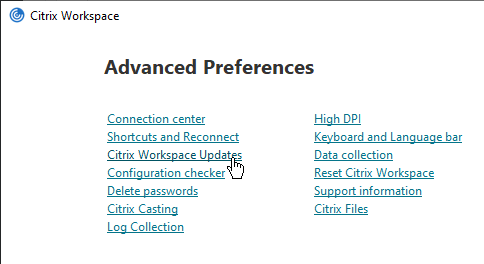
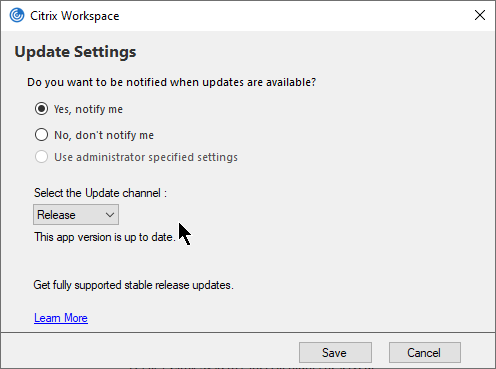
- See George Spiers Citrix Receiver for Windows Auto-Update.
Auto-update is configured using Workspace app group policy under the Citrix Workspace Updates, or Auto-Update node.
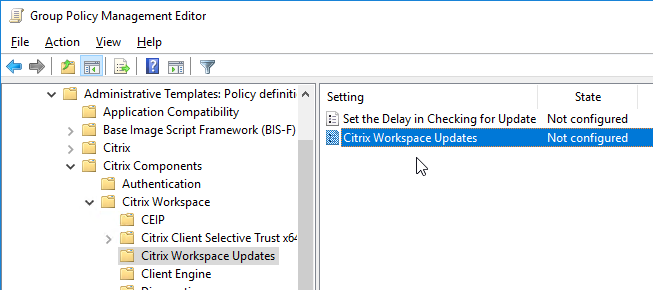
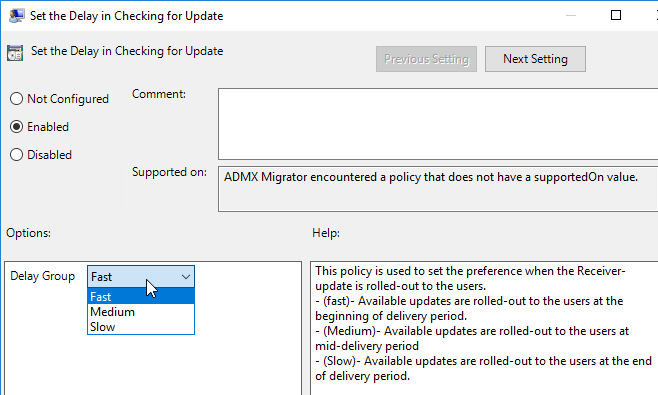
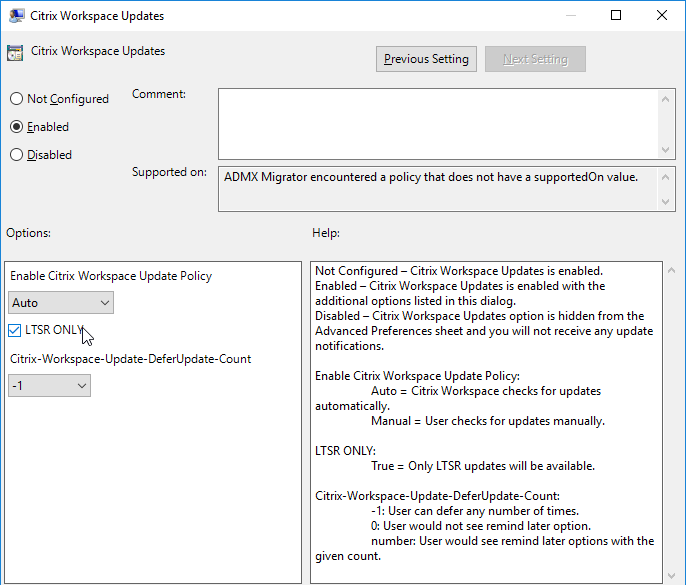
Or use Global App Configuration Service.

Workspace app Splash Screen
Workspace app shows a Splash Screen on first launch with the text “Citrix Workspace app extends the capabilities of Citrix Receiver”.
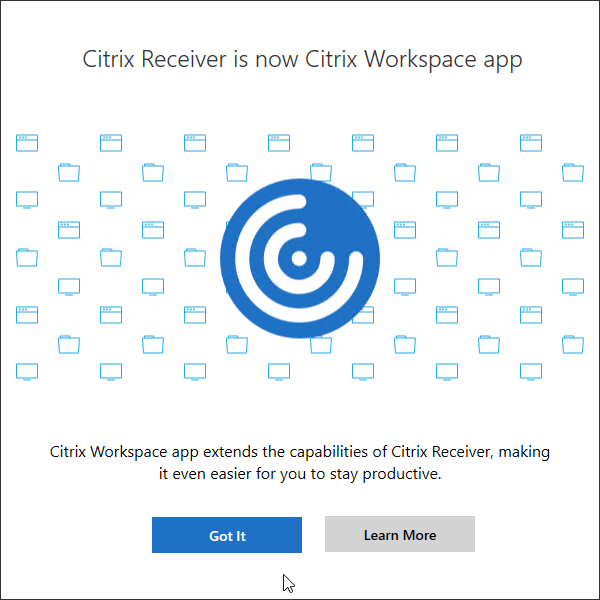
To prevent this splash screen, set the following registry value: (source = Dennis Span on Twitter)
- Key = HKEY_CURRENT_USER\SOFTWARE\Citrix\Splashscreen
- Value (REG_SZ) = SplashscreenShown = 1
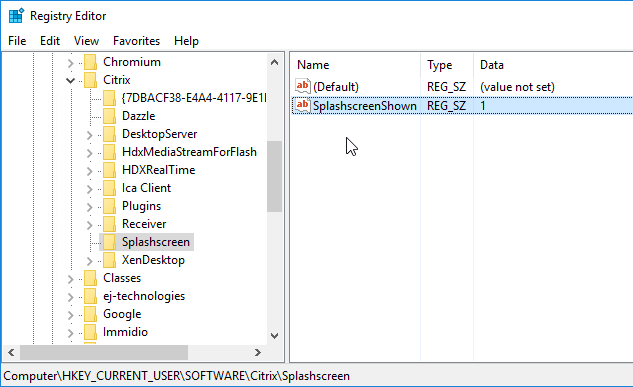
Add Account Wizard
After installation, Workspace app will launch and ask you to add an account. If Workspace app, notice the checkbox Do not show this window automatically at logon.
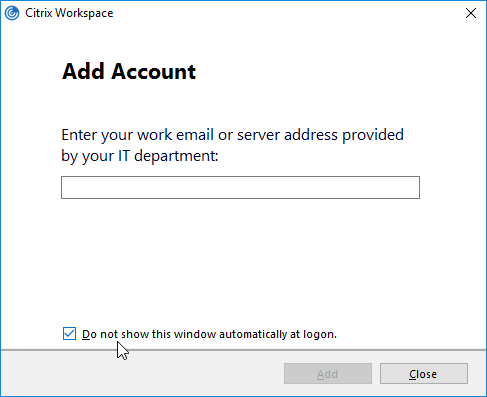
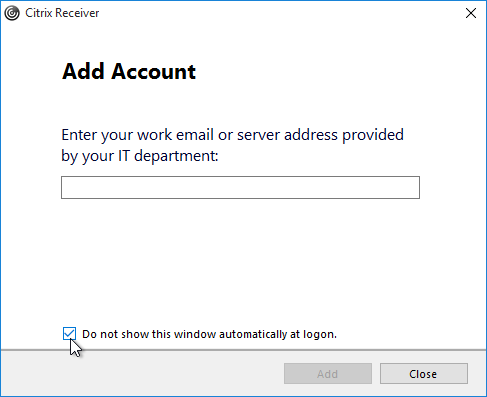
FTU (First Time Use aka Add Account Wizard) will be displayed only if a store is not configured. If a store is already configured via command line, GPO, or Citrix Studio, then FTU screen will not be available after installation. Otherwise, FTU can be suppressed by doing one of the following:
- Rename CitrixWorkspaceApp.exe to CitrixWorkspaceAppWeb.exe.
- Install using a command line switch:
- CitrixWorkspaceApp.exe /ALLOWADDSTORE=N
- Set the registry value: HKEY_LOCAL_MACHINE\SOFTWARE\Policies\Citrix\EnableFTU=dword:00000000 (or EnableX1FTU =dword:0)
- Disable the EnableFTU policy setting in Receiver.admx.
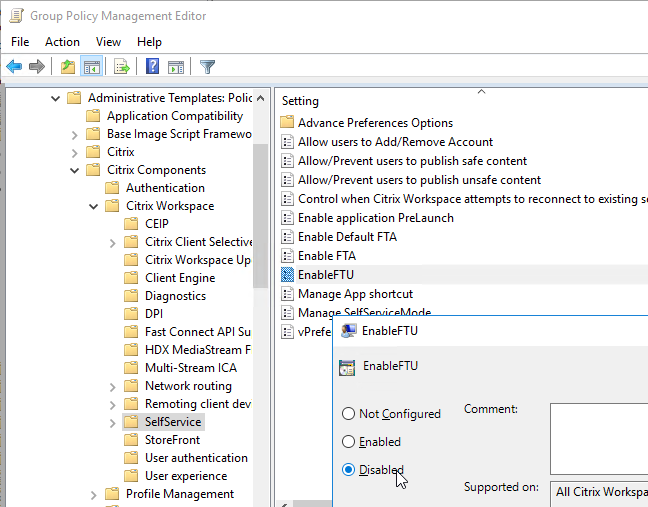
- Change Registry values post installation to suppress the Add Account window. Under HKLM\Software\Wow6432Node\Citrix\Dazzle, set AllowAddStore value to N.
- Set the registry value: HKEY_LOCAL_MACHINE\Software\Citrix\Receiver\NeverShowConfigurationWizard (REG_SZ) = true
- Also see Suppressing Add Account dialog at Citrix Docs.
Discover Hidden Stores
When Workspace app is first launched, it must perform Discovery, which is the process of downloading the .xml provisioning file from StoreFront. Discovery is performed by entering a StoreFront FQDN or Gateway FQDN. To discover a hidden store (a store that’s not advertised), add ?StoreName to the end of the FQDN. CTX214819 How to configure Receiver to a Store that is not advertised.
CitrixWorkspaceApp.exe Command line switches
CTX227370 Citrix Workspace app Commandline Tool contains a GUI tool to build your installer command line.

For unattended installation of Workspace app, see CTA Dennis Span Citrix Workspace App unattended installation with PowerShell or Citrix Receiver unattended installation with PowerShell.
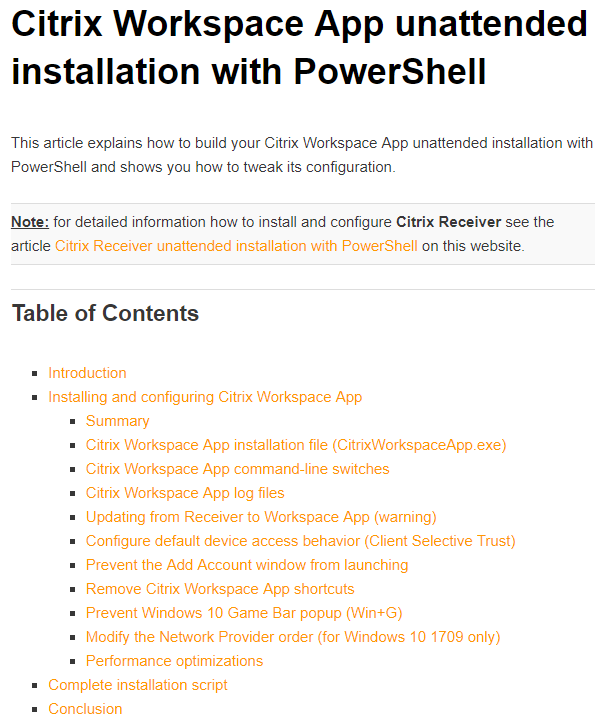
Installer Command Line Switches are detailed at Configure and install Receiver for Windows using command-line parameters at Citrix Docs. Common Command line switches include the following:
- /silent
- /includeSSON – enables pass-through authentication. GPO configuration is also required as detailed below.
CitrixWorkspaceApp.exe /includeSSON
- /ALLOWADDSTORE=A – by default, only SSL (HTTPS) stores are accepted. To allow non-SSL stores:
CitrixWorkspaceApp.exe /ALLOWADDSTORE=A
- /STORE0 – To add a store from the installation command line:
CitrixWorkspaceApp.exe STORE0="AppStore;https://Citrix.corp.com/Citrix/MyStore/discovery;on;App Store"
- Workspace App can discover the Store through NetScaler Gateway.
CitrixWorkspaceApp.exe STORE0="AppStore;https://gateway.corp.com#MyStore;On;App Store"
- Workspace App can discover the Store through NetScaler Gateway.
- /SELFSERVICEMODE=False – disables the Self-Service interface and enables shortcut-only mode:
CitrixWorkspaceApp.exe /SELFSERVICEMODE=False
- /AutoUpdateCheck=auto /AutoUpdateStream=LTSR – enables Citrix Workspace Update notifications and sets it to LTSR Branch only. AutoUpdateCheck can also be set to manual or disabled. AutoUpdateStream can also be set to Current. See Configuring Citrix Workspace Updates at Citrix Docs.
CitrixWorkspaceApp.exe /AutoUpdateCheck=auto /AutoUpdateStream=LTSR
- /ENABLEPRELAUNCH=True – enables prelaunch:
CitrixWorkspaceApp.exe /ENABLEPRELAUNCH=True
- /ALLOW_CLIENTHOSTEDAPPSURL=1 – enables Local App Access:
CitrixWorkspaceApp.exe /ALLOW_CLIENTHOSTEDAPPSURL=1
Registry values
HKLM\Software\Wow6432Node\Citrix\Dazzle on the Workspace app machine. All are of type REG_SZ (string) unless specified. Note: several of these are configurable using the Reciever.admx group policy template.
- SelfServiceMode (REG_SZ) = False – Turns off Workspace app’s Self-Service interface.
- PutShortcutsOnDesktop (REG_SZ) = True – If Self-Service interface is disabled, places all shortcuts on desktop.
- UseDifferentPathsforStartmenuAndDesktop (REG_SZ) = True
- UseCategoryAsStartMenuPath (REG_SZ) = True or False
- UseCategoryAsDesktopPath (REG_SZ) = True or False
- StartMenuDir (REG_SZ) = name of folder on Start Menu where shortcuts are placed.
- DesktopDir (REG_SZ) = name of folder on Desktop where shortcuts are placed
- EnablePreLaunch (REG_SZ) = True – If SSON is enabled then PreLaunch is already enabled by default.
- AllowAddStore (REG_SZ) = A – Only if using http (instead of https) to connect to StoreFront.
- AllowSavePwd (REG_SZ) = A – Only if using http (instead of https) to connect to StoreFront.
- UserDomainName (REG_SZ) = pre-filled domain name
- InitialRefreshMinMs (REG_SZ) = 1 – minimizes the launch delay before contacting store
- InitialRefreshMaxMs (REG_SZ) = 1 – minimizes the launch delay before contacting store
- RefreshMs (REG_SZ) = 3600000 (1 hour) – interval for Receiver icon refreshes. 1 hour is the default value.
- RefreshMs (REG_SZ) = 18000000 – Citrix CTX213755 Citrix Receiver Shows Authentication Window Periodically When Receiver is Not Opened
- MaxSimultaneousFetches (REG_DWORD) = 6 – improves the time of loading icons in Start Menu
- MaxSimultaneousSubscribes (REG_DWORD) = 6 – improves the time of loading icons in Start Menu
- DontWarnOfRemovedResources (REG_SZ) = True – prevents dialog boxes when resources are removed from the server. (or False)
- SilentlyUninstallRemovedResources (REG_SZ) = True – prevents dialog boxes when resources are removed from the server
- PreferTemplateDirectory (REG_SZ) = UNC path or local path containing shortcuts copied by the prefer keyword. Give the shortcuts a short name.
- PnaSSONEnabled (REG_SZ) = True – Enables Single Sign-on for PNAgent (Web Interface).
- WSCReconnectMode (REG_SZ) = 3 (default) – If this Workspace app is running inside a VDA published desktop, set it to 0.
- If you’re having trouble getting sessions to reconnect, see Receiver 4.3 Desktop will not auto-reconnect when logging into a machine at Citrix Discussions
- AlwaysUseStubs (REG_SZ) = True. Workspace app and Receiver 4.3.100 and newer don’t create .exe stubs by default. Set this to create .exe stubs. Also see Citrix CTX211893 Controlling Shortcut behavior in Receiver 4.3.100.
- DontCreateAddRemoveEntry (REG_SZ) = True – don’t create “Delivered by Citrix” entries in Programs and Features
- DesktopNameFormatString = format string for shortcut names – For example “{0}_{1}_{2}_{3}”. See the link for details.
- SelfServiceFlags (REG_DWORD) = 4 – prevents duplicate shortcuts when roaming and Desktop is redirected.
- SelfServiceFlags = 5 to stop external SSON from prompting for authentication
- ReEvaluateNetwork (REG_SZ) = true – for Beacon detection with Single FQDN
To prevent the Win+G popup on Windows 10 machines:
- HKEY_LOCAL_MACHINE\SOFTWARE\Policies\Microsoft\Windows\GameDVR
- AllowGameDVR (REG_DWORD) = 0
To allow adding non-HTTPS stores to Workspace app:
- HKLM\Software\Wow6432Node\Citrix\AuthManager
- ConnectionSecurityMode (REG_SZ) = Any
To increase ICA bandwidth consumption over high latency links, set:
- HKEY_LOCAL_MACHINE\SOFTWARE\Wow6432Node\Citrix\ICA Client\Engine\Configuration\Advanced\Modules\TCP/IP
- OutBufCountClient2 = Number of OutBufs (default is 44)
- OutBufCountHost2 = Number of OutBufs (default is 44)
- See CTX125027 How to Optimize HDX Bandwidth Over High Latency Connections for some recommended values (multiples of 44)
To prevent beacon probing from using proxy, set:
- HKEY_LOCAL_MACHINE\Software\WOW6432Node\Citrix\Receiver\inventory
- BeaconProxyEnabled (REG_DWORD) = 0
To enable foreground progress bar, set:
- HKEY_LOCAL_MACHINE\SOFTWARE\Wow6432Node\Citrix\ICA Client
- ForegroundProgressBar (REG_DWORD) = 1
For client-to-server file type redirection, set:
- HKEY_LOCAL_MACHINE\SOFTWARE\Wow6432Node\Citrix\ICA Client\Engine\Configuration\Advanced\Modules\ClientDrive
- NativeDriveMapping=”TRUE”
To fix USB devices that emulate a keyboard, set:
- HKEY_LOCAL_MACHINE\SOFTWARE\Wow6432Node\Citrix\ICA Client\Engine\Lockdown Profiles\All Regions\Lockdown\Virtual Channels\Keyboard
- KeyboardTimer=”10”
To remember manually mapped USB devices when auto-connection is enabled, set: (2409 and newer)
- HKLM\SOFTWARE\Citrix\ICA Client\GenericUSB (same path for 32-bit and 64-bit, create the keys)
- RememberConnections (DWORD) = 0x1
To override the devices that are mapped using optimized channels instead of generic USB, see Citrix CTX123015 How to Configure Automatic Redirection of USB Devices
Group Policy Settings
Copy the Workspace app ADMX template (C:\Program Files (x86)\Citrix\ICA Client\Configuration\receiver.admx) to C:\Windows\PolicyDefinitions (or Sysvol). Also copy receiver.adml to C:\Windows\PolicyDefinitions\en-us (or Sysvol).
Edit a GPO that applies to client machines, go to Computer Configuration | Policies | Administrative Templates | Citrix Components | Citrix Workspace and configure the following:
- To enable pass-through authentication: go to | User Authentication |.
- Local Username and Password – Check the top two boxes.
- Also add the StoreFront FQDN to the Local Intranet zone in Internet Explorer.
- Single Sign-on for NetScaler Gateway (Workspace app 1808 and newer)
- To add a store, go to | StoreFront |
- StoreFront Accounts List – see the help text
- To enable Auto-Update, go to | AutoUpdate | or | Citrix Workspace Updates |. (the node was renamed in 4.11 and Workspace app)
- Enable or Disable AutoUpdate or
- Citrix Workspace Updates
- To modify the desktop viewer toolbar, go to | Client Engine |
- Desktop Viewer Toolbar Options (2409 and newer)

- Desktop Viewer Toolbar Options (2409 and newer)
- To enable Local App Access, go to | User Experience |
- Local App Access Settings
- To prevent the endpoint from sleeping while session is active, go to | User Experience |
- Power Management (2405 and newer)
- To configure the Self-Service interface, go to | SelfService |
- Set Manage SelfServiceMode to Disabled to completely disable the Self-Service window. This causes all icons to be placed on the Start Menu.
- Enable Manage App Shortcut and configure it as desired.
- To allow the Self-Service window, but prevent it from automatically opening (reside in systray), tick Prevent Citrix Workspace performing a refresh of the application list when opened. Source
- Enable Control when Workspace attempts to reconnect to existing sessions. If this is a VDA published desktop, set it to Disabled. Otherwise configure it as desired.
- Set Enable FTU to Disabled to prevent the Add Account wizard from displaying.
- Enable Allow/Prevent users to publish unsafe content if publishing content that’s opens a file or file share.
Enable automatic client drive and client microphone mapping:
- In a client-side GPO, add the GPO ADM template from http://support.citrix.com/article/CTX133565.
- Enable the setting Create Client Selective Trust Keys. See Below for details.
- Configure the FileSecurityPermission setting in one or more of the regions.
- Configure the MicrophoneAndWebcamSecurityPermission setting in one or more of the regions.
Citrix CTX203658 Start Menu Icons Set to Default (Blank Document) After Update to Receiver 4.3.100 – Windows 8 and newer
- Computer Configuration | Policies | Administrative Templates | Windows Components | File Explorer
- Allow the use of remote paths in file shortcut icons = enabled
For Single Sign-on in Windows 11 24H2 and newer, enable the following GPO setting:
- Computer Configuration | Policies | Administrative Templates | Windows Components | Windows Logon Options
- Enable MPR notifications for the System = enabled

- Enable MPR notifications for the System = enabled
Deploy Workspace app using Active Directory
To deploy Workspace app using Active Directory, configure a GPO with a computer startup script that runs the Workspace app installer executable. Citrix provides sample scripts that can be downloaded from one of the Workspace app download pages (Workspace app current release version 2409.10, or LTSR version 2402 CU3, by expanding Downloads for Admins (Deployment Tools).

Also see CTA Dennis Span Citrix Receiver unattended installation with PowerShell.
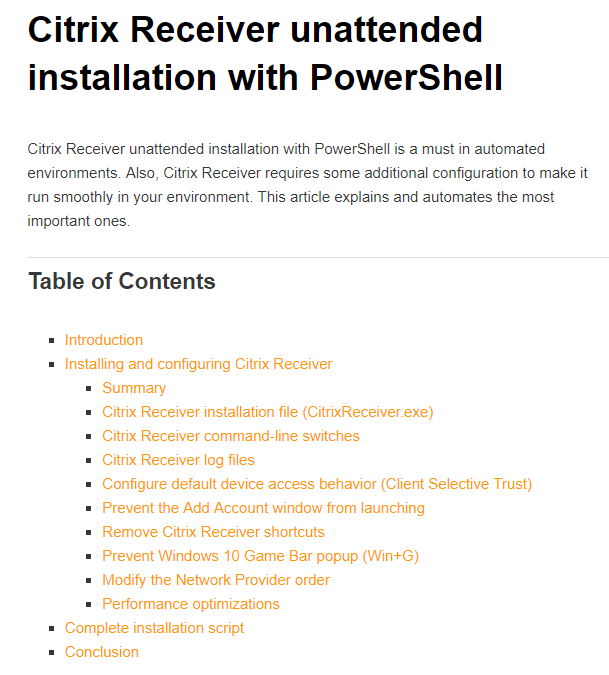
Change Workspace App’s Store Configuration, including Reset Citrix Workspace
You can change Workspace app’s configured Store/Account with a couple command lines:
"C:\Program Files (x86)\Citrix\ICA Client\SelfServicePlugin\SelfService.exe" -deleteproviderbyname Corporate "C:\Program Files (x86)\Citrix\ICA Client\SelfServicePlugin\SelfService.exe" -init -createprovider Corporate https://storefront.corp.com/Citrix/Store/discovery
It is sometimes necessary to Reset Citrix Workspace by right-clicking the Workspace app systray icon, clicking Advanced Preferences, and clicking the Reset link. You can do this from the command line by running "C:\Program Files (x86)\Citrix\ICA Client\SelfServicePlugin\CleanUp.exe" -cleanUser -silent. See CTX140149 How to Reset Receiver Using the Command Line.


Workspace app Group Policy ADMX Template
Many of the Workspace app configuration settings must be configured in group policy. These Workspace app settings are only available after installing the GPO templates.
Alternatively, Citrix Cloud customers can use Global App Configuration Service to configure Workspace app. Today it’s a REST API, but Citrix has started adding a GUI at Workspace Configuration > App Configuration.

For GPO configuration:
- From a machine that has Workspace app installed, find the .admx and .adml files in the C:\Program Files (x86)\Citrix\ICA Client\Configuration.
- Copy the CitrixBase.admx and receiver.admx files. Also copy the en-US folder. In Workspace app, the files are still named receiver.admx.

- Go to your domain’s SYSVOL share and in the Policies folder look for a PolicyDefinitions folder. If one exists, paste the .admx file directly into the PolicyDefinitions folder. If this folder doesn’t exist in SYSVOL, instead copy the .admx file to C:\Windows\PolicyDefinitions. Overwrite any existing Receiver ADMX files.
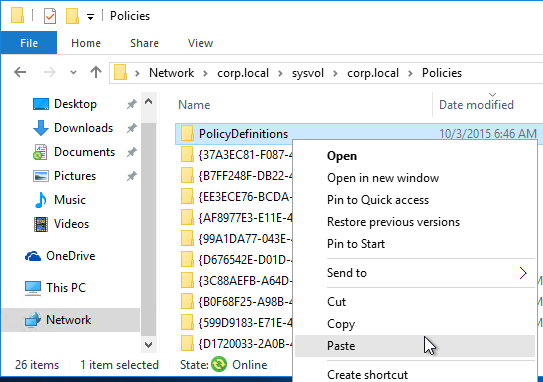
- The GPO settings can then be found at one of the following:
- Computer Configuration > Policies > Administrative Templates > Citrix Components > Citrix Workspace
- Computer Configuration > Policies > Administrative Templates > Citrix Components > Citrix Receiver
- For example, you can disable Customer Experience Improvement Program (CEIP) from here.
- See https://www.carlstalhood.com/delivery-controller-cr-and-licensing/#ceip for additional places where CEIP is enabled.
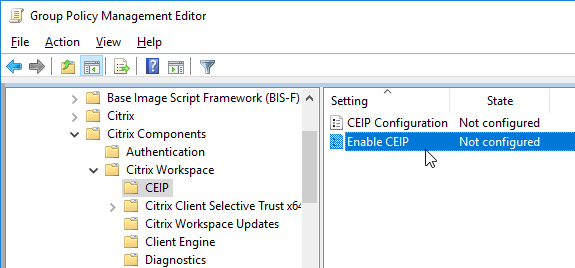
- Workspace app 1905 and newer has a setting to Disable sending data to 3rd party (e.g., Google Analytics).
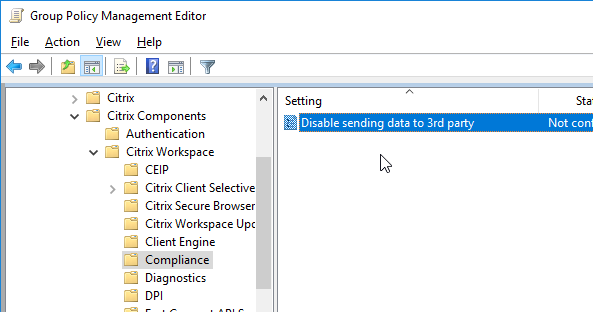
- Workspace app 1905 and newer let you disable embedded browser caching.
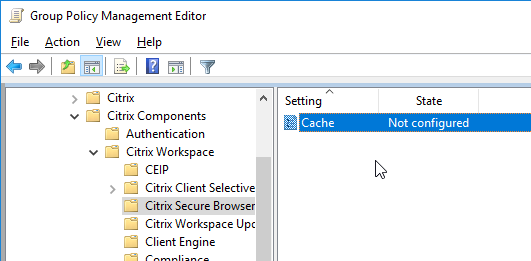
- Workspace app 1905 and newer have NetScaler LAN Proxy under Network routing > Proxy.
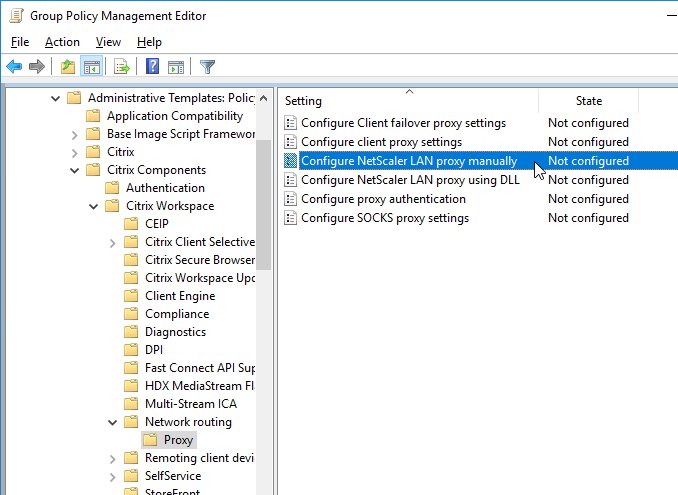
- Workspace app 1808 and newer have User authentication | Single Sign-on for NetScaler Gateway.
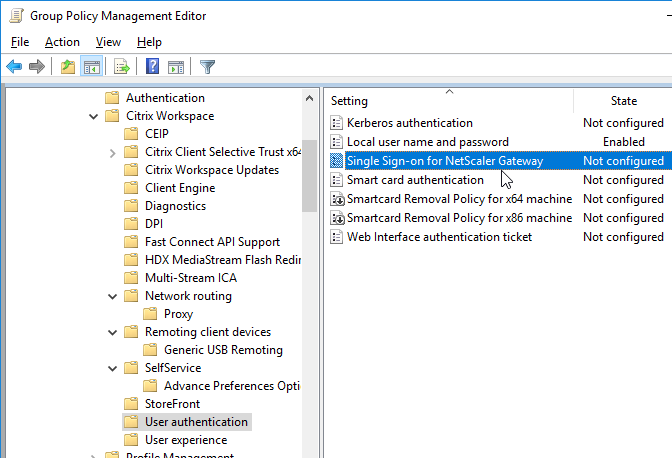
- Citrix Workspace Updates, (aka AutoUpdate) can be configured using group policy. See Configuring Citrix Workspace Updates at Citrix Docs.
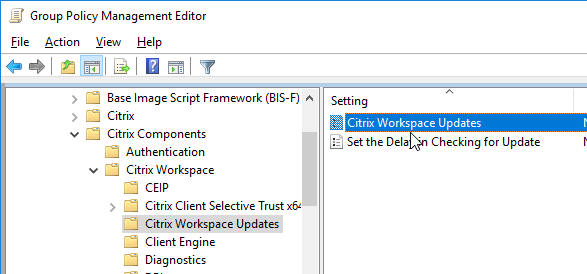
- Workspace app 1912 and newer can be configured to require in-memory ICA files only. The setting called Secure ICA file session launch is under the Client Engine node. See Citrix Docs for details on in-memory ICA files instead of writing ICA files to disk.
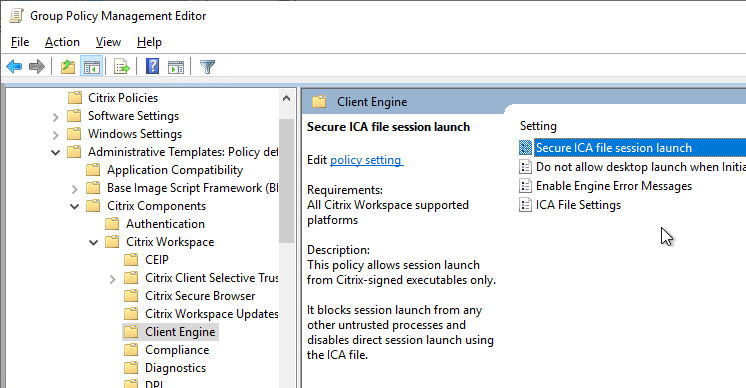
- The DPI node has a setting called High DPI that lets you disable DPI matching, which is enabled by default in Workspace App 2206 and newer.
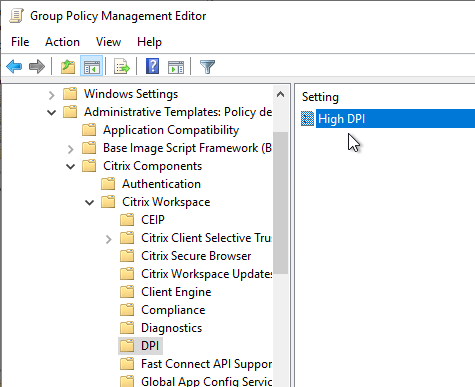
- Workspace app 2210 and newer let you use the GUI to re-enable High DPI.
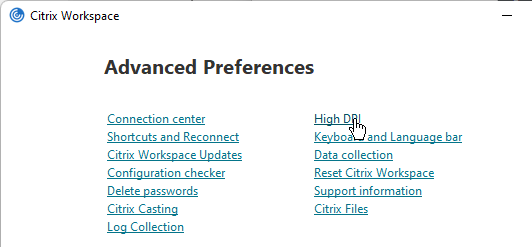
- Native resolution means DPI matching, whereas Yes means force high DPI.
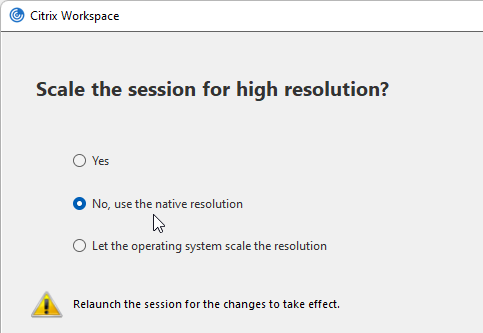
- Workspace app 2210 and newer let you use the GUI to re-enable High DPI.
- Workspace app has settings to hide Advanced Preferences, enable/disable showing the DPI option, and enable/disable H265.
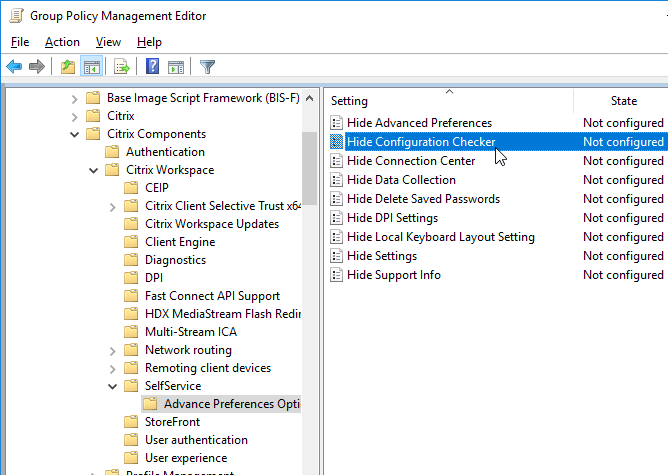
- Workspace app 4.8 and newer have SplitDevices GPO setting under Citrix Workspace | Remoting client devices | Generic USB Remoting. See Configuring composite USB device redirection at Citrix Docs.
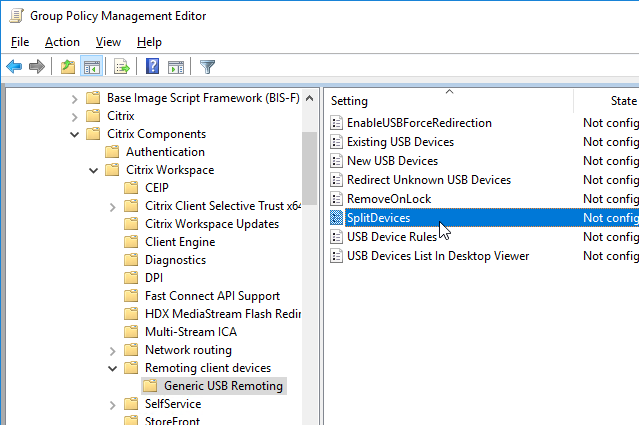
- Workspace app 2212 and newer by default disable App Protection for the authentication screen and icons list. To enable them, configure User authentication | Manage App Protection and SelfService | Manage App Protection.


- Workspace app 2303 and newer have Anti-DLL Injection for App Protection. It is disabled by default. Enable it in a GPO at Citrix Components | Citrix Workspace | App Protection | Anti-DLL Injection. See Citrix Docs for details.


Pass-through Authentication
Citrix blog post – A Comprehensive Guide to Enabling Pass-Through Authentication with XenDesktop 7.5
- Run the command
Set-BrokerSite -TrustRequestsSentToTheXmlServicePort $True from a Windows PowerShell command prompt on a Delivery Controller.

- In XenApp 6.5, this is a Citrix Policy > Computer > Trust XML Requests.
- Login to the PC as an administrator.
- If installing Workspace app, as an administrator, during installation, on the Enable Single Sign-on page, check the box next to Enable Single Sign-on. Then finish the installation.
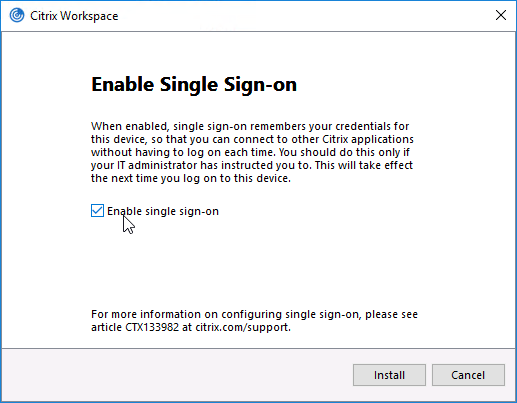
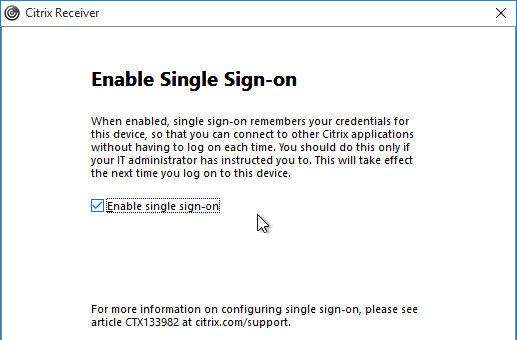
- To verify that SSON is installed, go to C:\Program Files (x86)\Citrix\ICA Client and look for the file ssonsvr.exe.
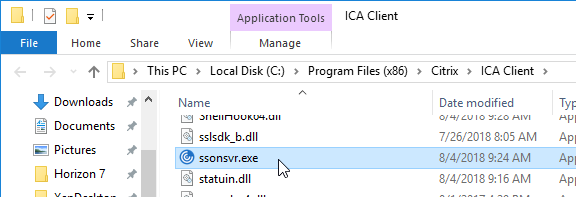
- And if you open regedit and go to HKLM\SYSTEM\CurrentControlSet\Control\NetworkProvider\Order, you should see PnSson in the ProviderOrder.
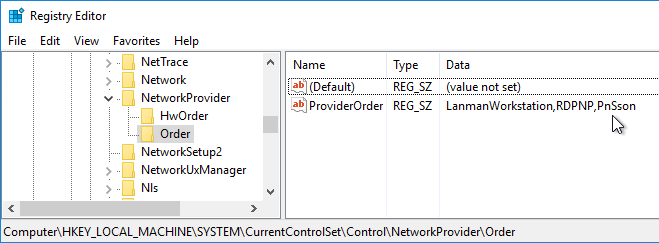
- Install the receiver.admx (and .adml) template into PolicyDefinitions if you haven’t already.
- Edit a GPO that is applied to the client PCs where the Workspace app is installed.
- Go to Computer Configuration > Policies > Administrative Templates > Citrix Components > Citrix Workspace.
- Expand Citrix Workspace and click User authentication.
- On the right, double-click Local user name and password.
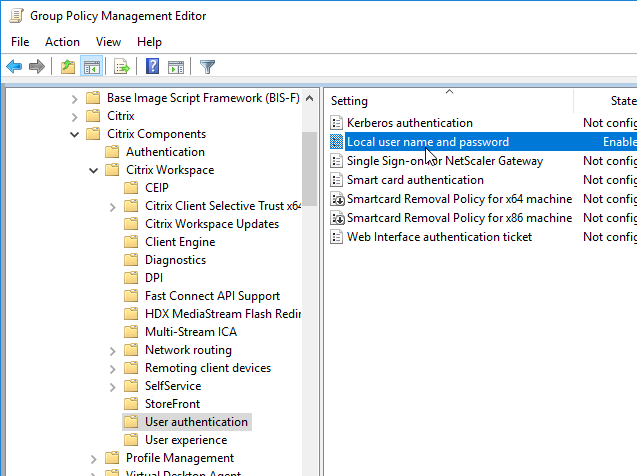
- Select Enabled and then check the box next to Allow pass-through authentication for all ICA connections. Click OK.
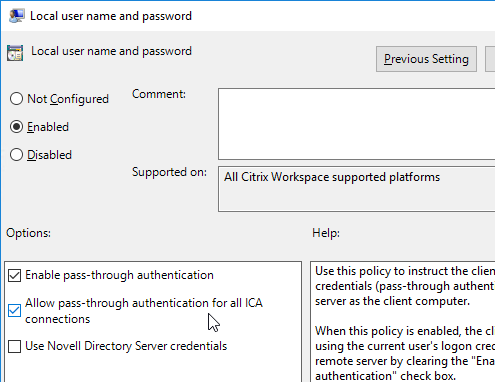
- In Workspace app 1808 and newer, you can enable Single Sign-on for NetScaler Gateway.
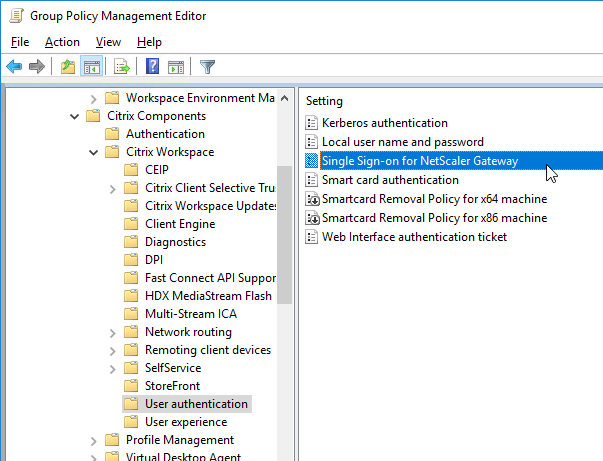
- Ensure that the internal StoreFront FQDN is in the Local Intranet zone in Internet Explorer. You can use a GPO to configure this on the client side.
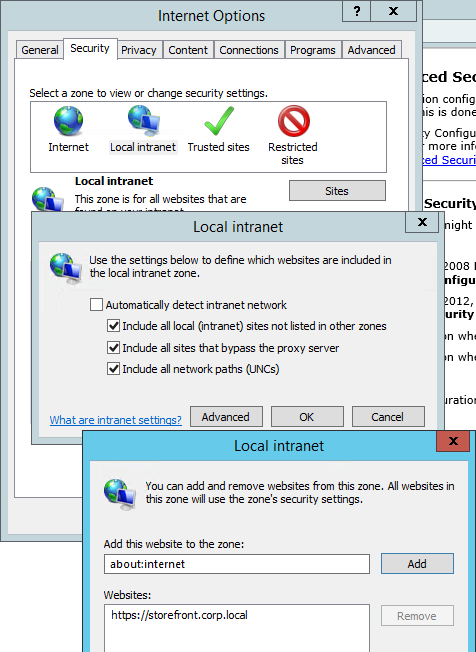
- Local Intranet zone should have Automatic logon only in Intranet zone enabled.
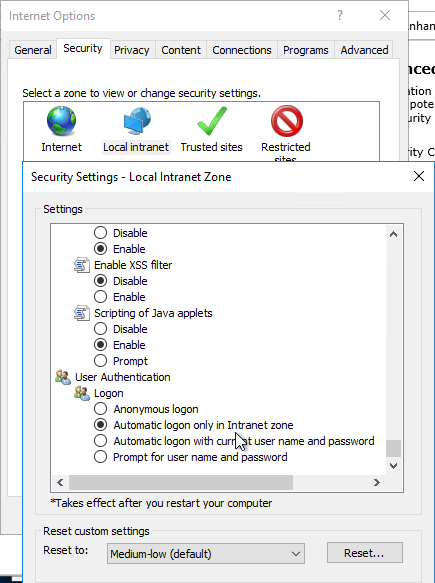
- For Windows 11 24H2 and newer, make sure the GPO setting Enable MPR notifications for the System is enabled at Computer Configuration | Policies | Administrative Templates | Windows Components | Windows Logon Options. Make sure HKLM\Software\Microsoft\Windows\CurrentVersion\Policies\System\EnableMPRNotifications is set to 1 on the Workspace app machine.

- Logoff Windows and log back on. In Task Manager you should now see ssonsvr.exe. This won’t appear unless you logoff and log back on.
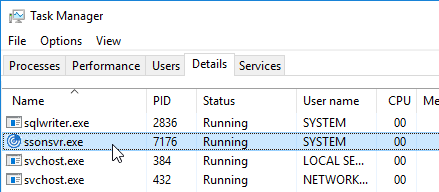
- If Workspace app won’t connect or is slow to enumerate icons, then you might have to disable Automatically detect settings in IE.
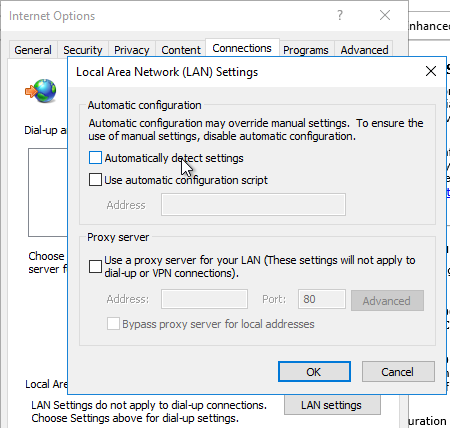
- Right-click the Workspace app icon and click Advanced Preferences.

- Click Configuration Checker.
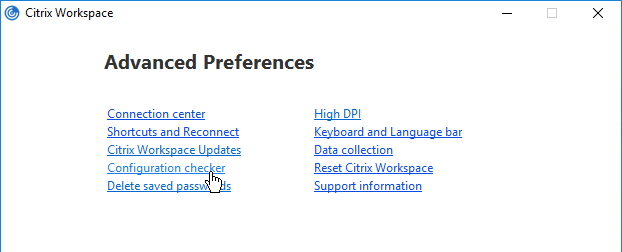
- Check the box next to SSONChecker and click Run.
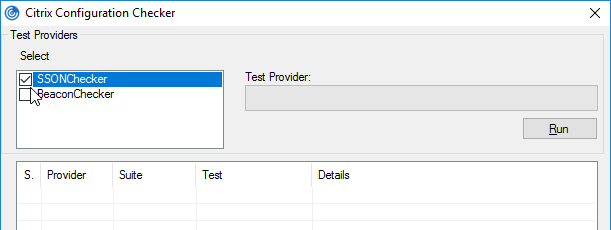
- The lines with red x will indicate the issue and corrective action.
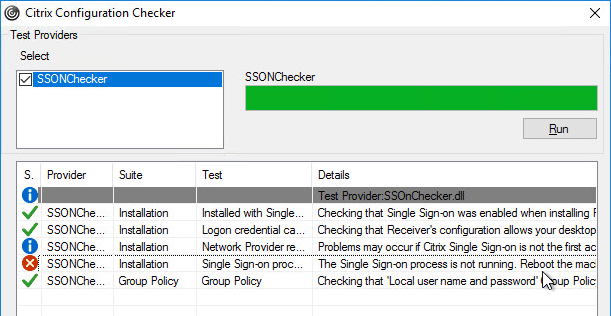
StoreFront Accounts
You can use a client-side GPO to add a store (Account) to Workspace app Self-Service.
- Install the receiver.admx (and .adml) template into PolicyDefinitions if you haven’t already.
- Edit a GPO that applies to endpoint devices that have Citrix Workspace app installed.
- Go to Computer Configuration > Administrative Templates > Policies > Citrix Components > Citrix Workspace > StoreFront.
- On the right, double-click NetScaler Gateway URL/StoreFront Accounts List.
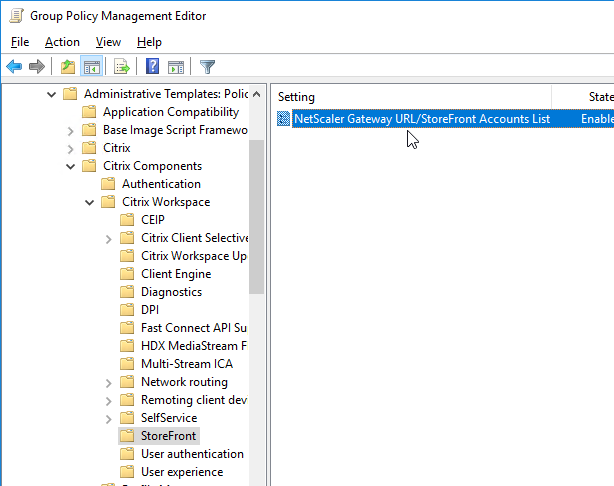
- Select Enabled, and then click Show.
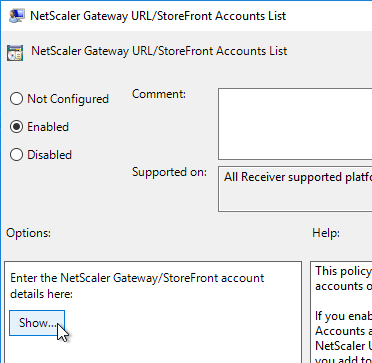
- Enter a store path based on the example shown in the Help box. Workspace app lets you enter a Gateway path. Then click OK.
- Note: Gateway paths work in GPO, but might not work when specified in the CitrixWorkspaceApp.exe installation command line.
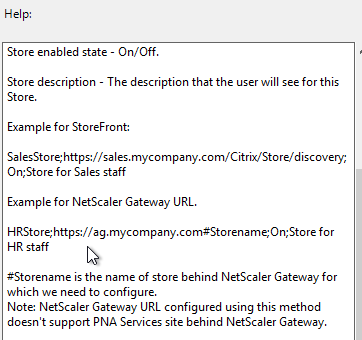

Published Shortcuts and Reconnect
Citrix CTX200924 How to Customize App Shortcuts with Receiver for Windows
Workspace app has a user interface for setting Shortcut Paths. Right-click the Workspace app systray icon, click Advanced Preferences, and then click Shortcuts and Reconnect, or Settings Option.

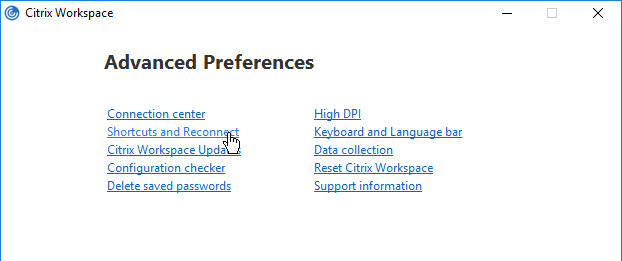
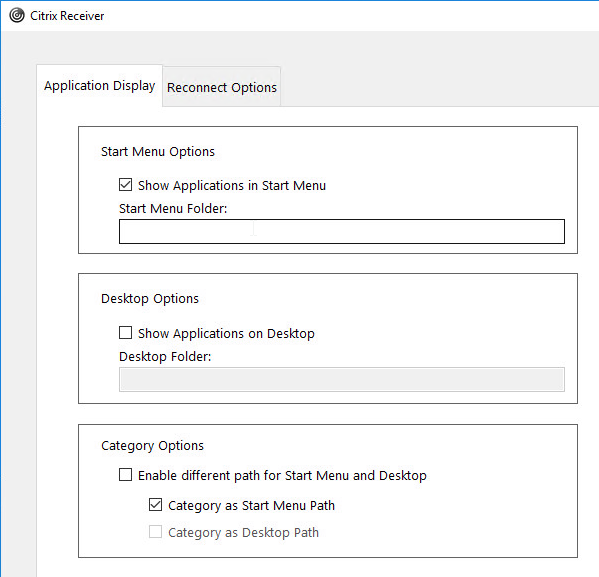
From Citrix Docs Configuring application delivery: There are several methods of controlling how Workspace app displays shortcuts on the Start Menu and Desktop as detailed below:
- Workspace app Registry values
- receiver.admx GPO Template
- From StoreFront in C:\inetpub\wwwroot\Citrix\Roaming\web.config
- Published App Keywords (e.g. prefer).
- Workspace app and Receiver 4.2.100 and newer supports published app Delivery configuration for adding the shortcut to the desktop. This only works if the app is a Favorite, or if Favorites are disabled, or Mandatory Store.
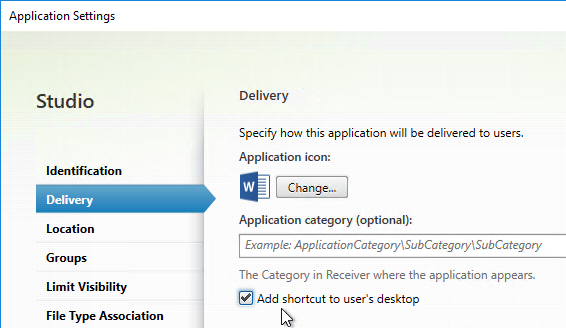
Under HKLM\Software\Wow6432Node\Citrix\Dazzle (or HKCU\Software\Wow6432Node\Citrix\Dazzle) are several registry values related to shortcuts. Some of the settings only apply if SelfServiceMode is set to False. Here are some common options:
- SelfServiceMode – set to False so Receiver disables the Self-Service interface and automatically places all published shortcuts on the Start Menu and/or Desktop. More details in Configuring application delivery at Citrix Docs.
- PutShortcutsOnDesktop – set to True to place every app on the desktop
- DesktopDir – Workspace app places every shortcut on the desktop so it’s probably best to place them in a folder.
- StartMenuDir – If there is potentially a conflict between local apps and remote apps, then you should place the Start Menu shortcuts in a folder.
- PreferTemplateDirectory (with KEYWORDS:prefer=shortcutname) – copies the shortcutname from the template directory to the Start Menu and/or Desktop.
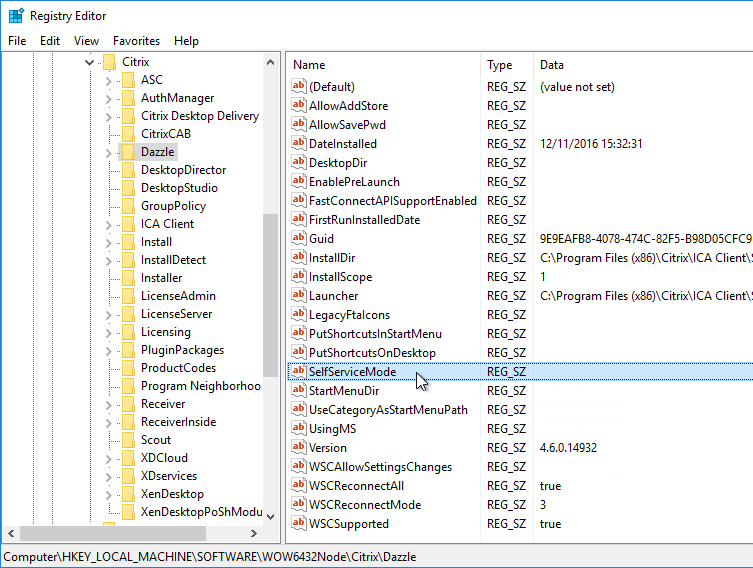
If you import the receiver.admx (and .adml) into the PolicyDefinitions folder, under Computer Configuration > Administrative Templates > Citrix Components > Citrix Workspace (or Receiver) is a node called SelfService.
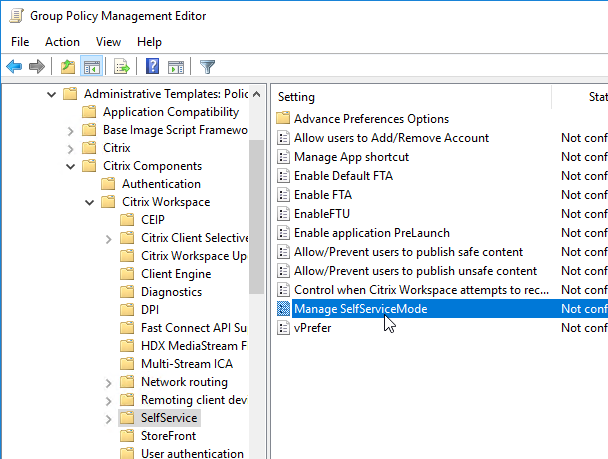
Disable the Manage SelfServiceMode setting to hide the Workspace app Window.
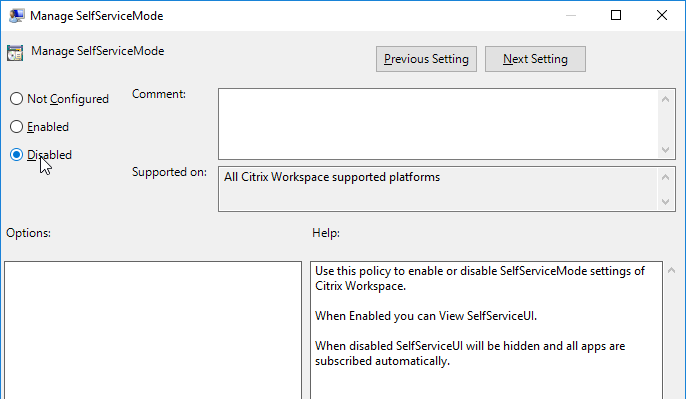
Enable the Manage App shortcut setting to control placement of shortcuts.
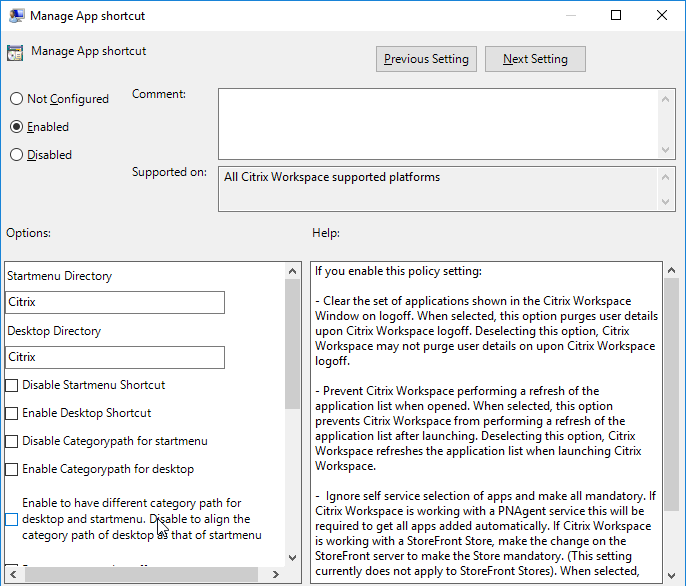
Workspace app and Receiver 4.2.100 and newer have the ability to configure (or disable) Workspace Control using group policy. Enable the setting Control when Citrix Workspace attempts to reconnect to existing sessions and configure it as desired.
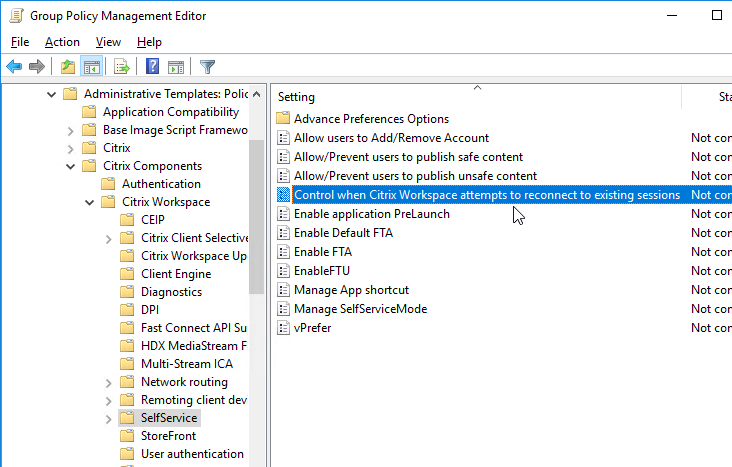
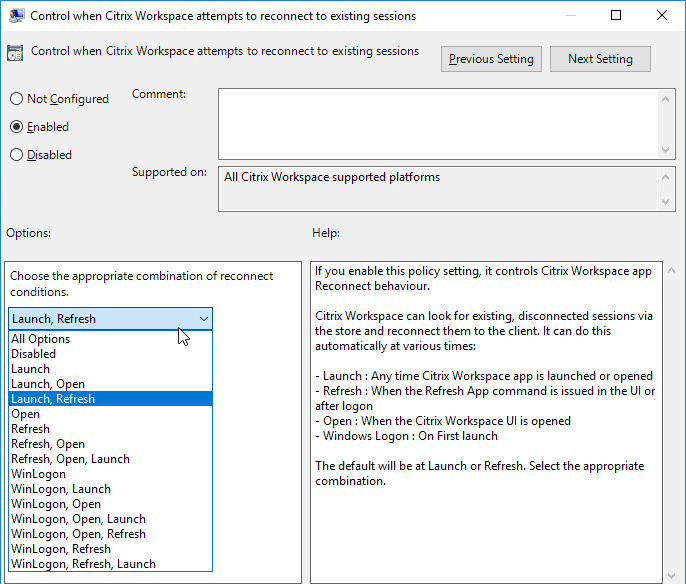
Prelaunch
Staring with Receiver 4.2, prelaunch is automatically enabled if Workspace app is installed with SSON enabled. Otherwise, set registry values to enable prelaunch. Receiver 4.2.100 prevents the prelaunch icon from appearing on the Start Menu.
- HKLM\Software\[Wow6432Node\]Citrix\Dazzle
- EnablePreLaunch (REG_SZ) = true or false
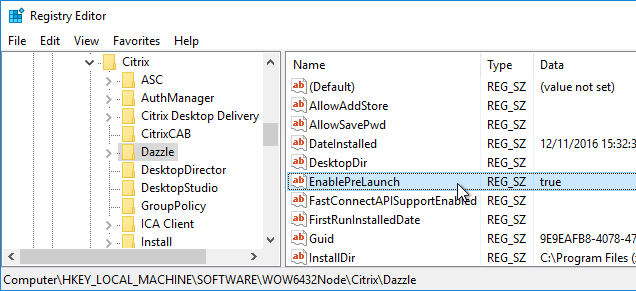
Additional customizations can be configured at:
HKEY_LOCAL_MACHINE\SOFTWARE\Wow6432Node\Citrix\ICA Client\Prelaunch
- Name: State
- REG_SZ: 0 = disable, 1 = just-in-time pre-launch, 2 = scheduled pre-launch
- Name: Schedule
- REG_SZ: HH:MM|M:T:W:TH:F:S:SU where HH and MM are hours and minutes. M:T:W:TH:F:S:SU are the days of the week. For example, to enable scheduled pre-launch on Monday, Wednesday, and Friday at 1:45 p.m., set Schedule as Schedule=13:45|1:0:1:0:1:0:0 . The session actually launches between 1:15 p.m. and 1:45 p.m.
- Name: UserOverride
- REG_SZ: 0 = HKLM overrides HKCU, 1 = HKCU overrides HKLM
Device Access Behavior (Client Selective Trust)
When connecting to a XenApp/XenDesktop session, you might see the following:
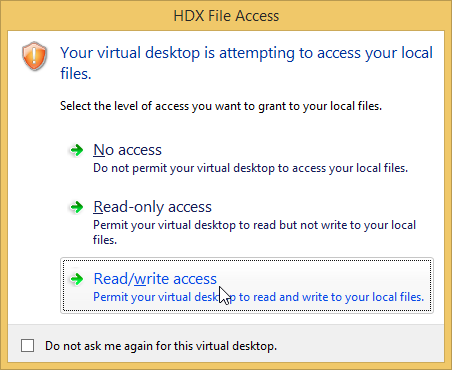
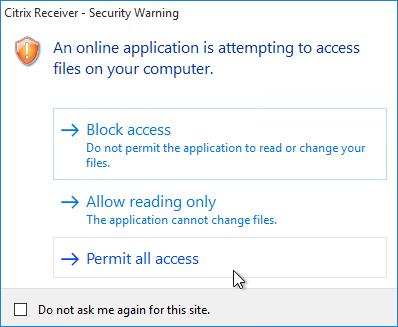
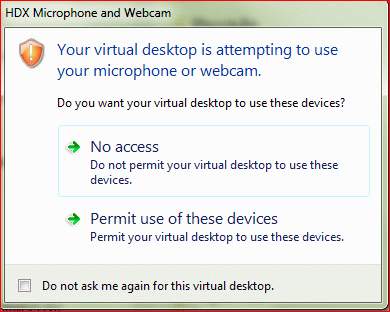
To configure the default behavior, see the Citrix Knowledgebase article How to Configure Default Device Access Behavior of Receiver, XenDesktop and XenApp. Note: there is a bug fixed in Receiver 4.2.100 and newer.
- Download the ADMX file from http://support.citrix.com/article/CTX133565.

- Copy the .admx and .adml files to PolicyDefinitions (Sysvol, or C:\Windows).
- The .adml file goes in the en-US folder.
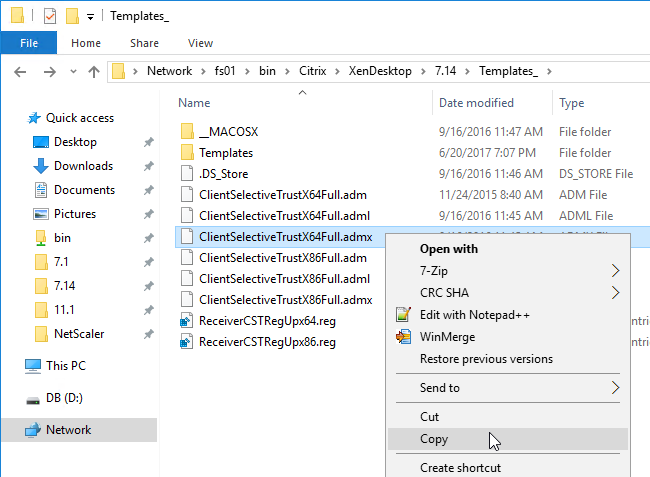
- Edit a GPO that applies to the endpoint devices that are running Receiver.
- Go to Computer Configuration | Policies | Administrative Templates | Citrix Components | Citrix Workspace (or Receiver) | Citrix Client Selective Trust (x64).
- Enable the setting Create Client Selective Trust Keys.
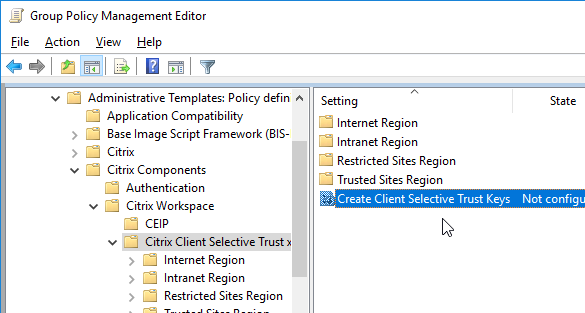
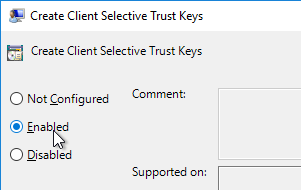
- Then expand the regions, and configure the permission settings as desired.
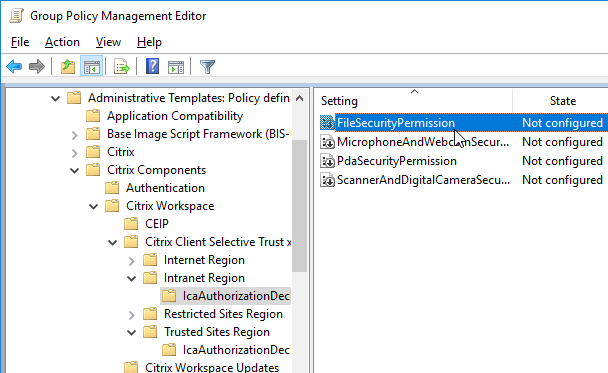
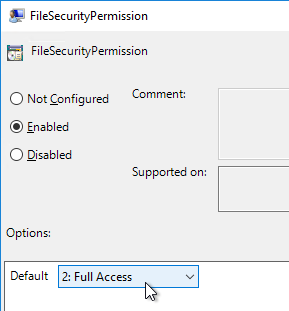
Desktop Lock
As an alternative to Workspace app Desktop Lock, see Transformer in Citrix Workspace Environment Manager.

External links:
- Dale Scriven YouTube video – Citrix Desktop Lock installation and configuration
- Jarian Gibson and Andrew Morgan – Citrix Receiver Desktop Lock
- An alternative to Desktop Lock – ThinKiosk
Use Studio to configure Workspace app Accounts in Published Desktop
In published desktops, Workspace app can be used for placement of shortcuts on the user’s Start Menu and Desktop. Use group policy to hide the common program groups and then use Workspace app to place published applications back on the Start Menu and Desktop based on user’s group membership and subscription preference.
- In Citrix Studio, on the left, expand the Configuration node, right-click StoreFront and click Add StoreFront.
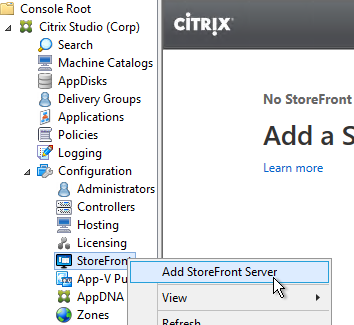
- Enter a descriptive name for the StoreFront server.
- Enter the internal https URL of the load balanced StoreFront servers. Add the path to your store (e.g. /Citrix/Store) and then /discovery on the end of the URL. The full URL would be similar to https://citrix.corp.com/Citrix/Store/discovery. Click OK.
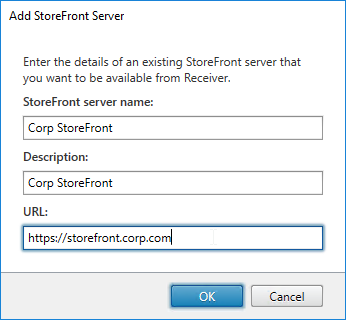
- Edit a Delivery Group that has a published desktop and Citrix Workspace app installed.
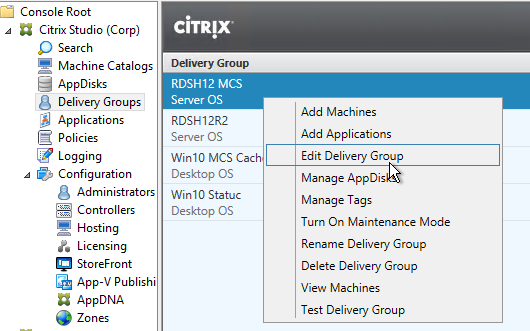
- On the StoreFront page, change the selection to Automatically, using the StoreFront servers selected below, and then check the box next to the StoreFront URL. Click OK. Now when users launch the published desktop, Workspace app will be automatically configured with this URL.
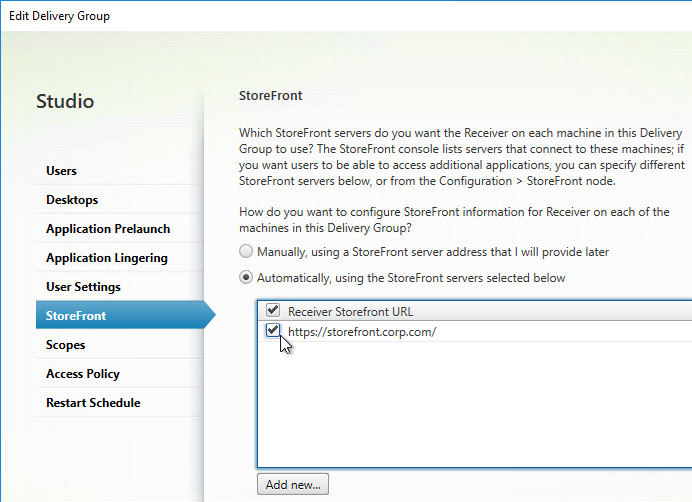
Published Desktop – use Workspace app to control Shortcuts
If you install Workspace app inside a published desktop (Workspace app on a VDA), then Workspace app can get icons from StoreFront and put those icons on the user’s published desktop Start Menu and Desktop. This is an alternative to using a User Experience Management product to control shortcut placement.
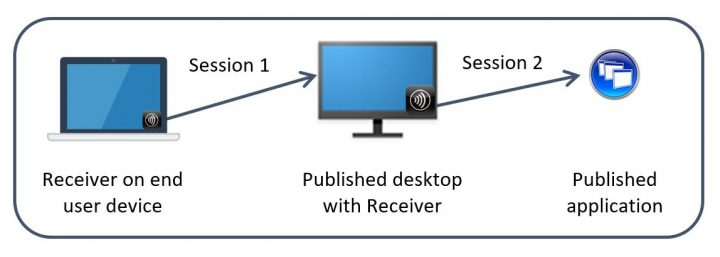
Note: Workspace app tends to be slow to create Start Menu shortcuts, so make sure you perform a Proof of Concept to determine how this functionality impacts logon times.
Configuration of Workspace app inside a published desktop is simplified if you have the following minimum versions:
- Workspace app installed inside the VDA
- VDA 7.17 or newer
- StoreFront 3.14 or newer
If you meet these minimum version requirements, then Workspace app installed in the VDA automatically tries to launch published applications on the same local VDA rather than trying to launch them from a different VDA (aka double-hop). This feature is called vPrefer.
- If you don’t meet these minimum version requirements, then you’ll need to use the older Prefer Keyword method of handling Workspace app shortcuts as detailed later.
- For a detailed explanation of vPrefer, see Citrix Blog Post VPrefer: Session Sharing Between a Published Desktop and a Published Application Made Easy
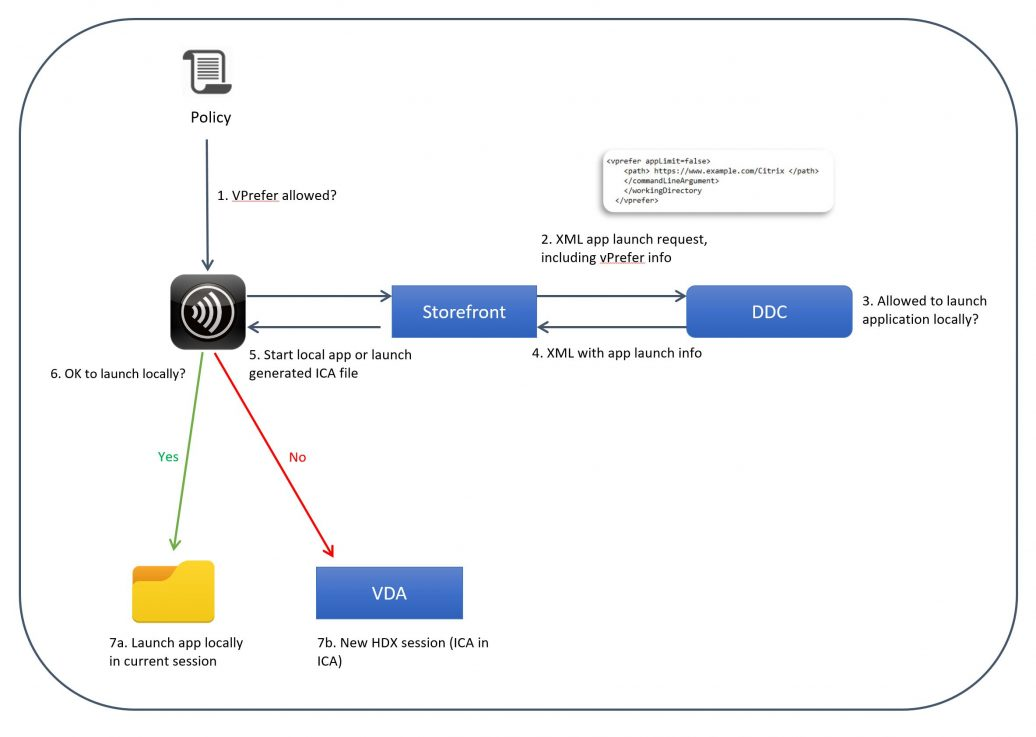
Do the following for all versions of Workspace app, VDA, and StoreFront, whether using the Prefer keyword or not:
- Make sure Workspace app or Receiver version 4.11 or newer is installed on the VDA.
- Install the Workspace app ADMX files if you haven’t already. For vPrefer, make sure they are the ADMX files from Workspace app.
- Enable the Group Policy setting Remove common program groups from Start Menu and apply it to non-administrators.
- This removes all Public (aka All Users) Start Menu shortcuts. Workspace app will re-add the shortcuts based on user group membership.
- On the VDA, configure the following Workspace app Registry keys (or corresponding settings in the receiver.admx GPO template):
- HKEY_LOCAL_MACHINE\SOFTWARE\Wow6432Node\Citrix\Dazzle\WSCReconnectMode=”0″ so Workspace app doesn’t try to reconnect to the published desktop you’re already running.
- HKEY_LOCAL_MACHINE\SOFTWARE\Wow6432Node\Citrix\Dazzle\SelfServiceMode to False. This turns off the Workspace app Self-Service GUI and acts like all icons are subscribed. Otherwise, only subscribed (favorited) icons would be placed on the Start Menu and Desktop.
- HKEY_LOCAL_MACHINE\SOFTWARE\Wow6432Node\Citrix\Dazzle\UseCategoryAsStartMenuPath = True. This creates a Start Menu folder based on the published app’s configured Category.
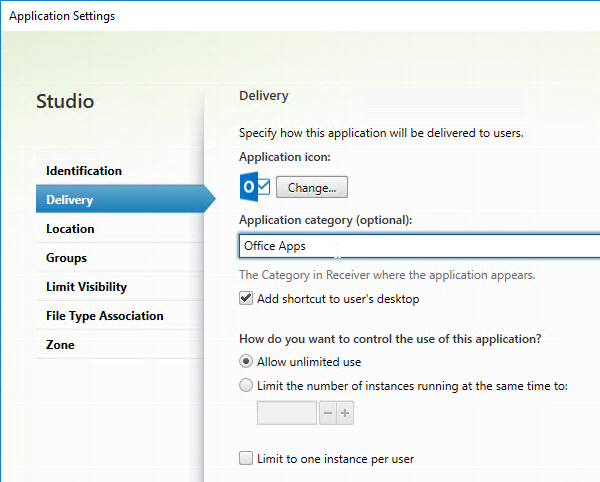
- Configure each desired published app to Add shortcut to user’s desktop.
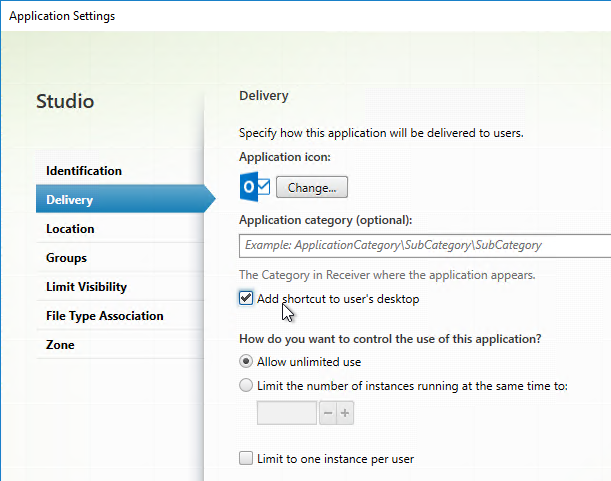
- Or, configure HKEY_LOCAL_MACHINE\SOFTWARE\Wow6432Node\Citrix\Dazzle\PutShortcutsOnDesktop = True to place all icons on the desktop.
- To control icon placement, configure the following registry values:
- HKEY_LOCAL_MACHINE\SOFTWARE\Wow6432Node\Citrix\Dazzle\StartMenuDir to place published applications in a sub-folder. Note: Windows Server 2012 and Windows 10 and newer only supports a single level of Start Menu folders, so setting this effectively turns off published app categories.
- HKEY_LOCAL_MACHINE\SOFTWARE\Wow6432Node\Citrix\Dazzle\DesktopDir to place published applications in a sub-folder on the desktop.
- Pass-through authentication:
- In a GPO that applies to the VDA, import the receiver.admx file, and set Local user name and password to Enabled. Check the box next to Allow pass-through authentication for all ICA connections.
- If you’re using Gateway internally, and if Workspace app 1808 or newer, then also enable Single Sign-on for NetScaler Gateway.
- In a user-level GPO that applies to the VDA, add the StoreFront FQDN to the Local Intranet zone. Make sure it is not in the Trusted Sites zone, or enable Automatic logon with current user name and password for the Trusted Sites zone.
- Make sure ssonsvr.exe is running after you login to the VDA. If not, troubleshoot it.
- When configuring Citrix Profile Management, make sure !ctx_startmenu! is not excluded from roaming.
- In Citrix Studio, configure a Delivery Group with delivery type = Desktop and Applications. Assign users to the delivery group, and the individual published applications (if visibility is limited).
- In Citrix Studio, edit each published application, and on the Delivery tab, specify a category. This will become the Start Menu folder name.
- If Workspace app Self Service Mode (GUI) is enabled, in Studio, edit each application, and add KEYWORDS:Auto and/or KEYWORDS:Mandatory to the published application description. This forces the applications to be subscribed/favorited. Only subscribed (or Favorite) apps are displayed in the Start Menu and Desktop. Unless you disable Workspace app’s SelfService interface as described earlier.
- Another option is to go to the StoreFront Console, click Stores on the left, and on the right, click Configure Store Settings, and click Disable User Subscriptions. This causes all apps to appear on the Start Menu and/or Desktop depending on Workspace app configuration.
- Create a group policy that applies to VDAs, and configure the group policy to define the Store URL for Workspace app similar to https://citrix.corp.com/Citrix/Store/discovery. Replace the FQDN with your load balanced StoreFront FQDN. Also replace the path to the store with your store path. Make sure there is /discovery on the end. By default, Workspace app and Receiver only support https.
- Your StoreFront store probably delivers both application and desktop icons. If you want to filter out the desktop icons, then create a new StoreFront store, and configure the Workspace app on the VDA to connect to the new Store.
- In StoreFront Console, click the store for VDAs, and click Configure Store Settings. On the Advanced Settings page, in the Filter resources by type row, choose Citrix.MPS.Desktop.
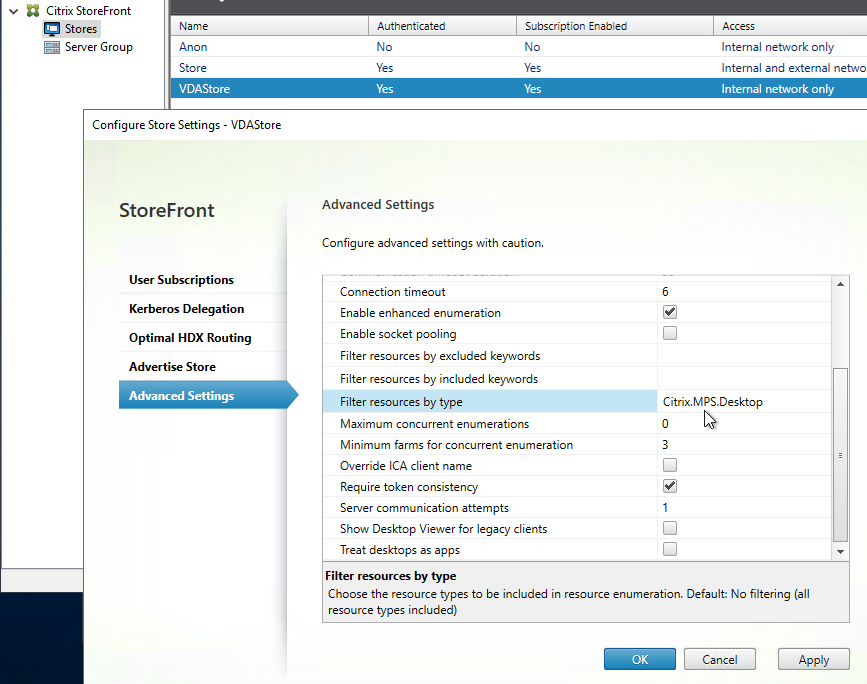
- For vPrefer in Workspace app, VDA 7.17 (or newer), and StoreFront 3.14 (or newer), edit a GPO that applies to the VDAs.
- Go to Computer Configuration | Policies | Administrative Templates | Citrix Components | Citrix Workspace (or Receiver) | SelfService.
- Edit the setting vPrefer. This setting is only in Workspace app ADMX templates from Workspace app.
- Set it to Allow all apps. Source = 7.17 vPrefer – not working with 32Bit Apps at Citrix Discussions.
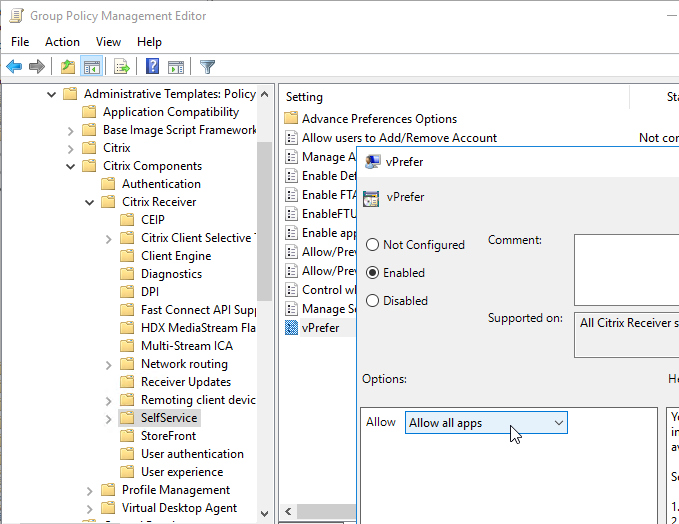
- On your Delivery Controller, in PowerShell, run set-brokersite -TrustRequestsSentToTheXmlServicePort $true
- This is required for Pass-through Authentication from Workspace app.
- Configure your client devices to connect to the published desktop.
- When users connect to the published desktop, Workspace app will auto-launch and hopefully auto-login.
- If Workspace app Self-Service Mode is disabled, all published applications should automatically appear in the Start Menu and Desktop.
- If Workspace app Self-Service Mode is enabled, then only applications with KEYWORDS:Auto and/or KEYWORDS:Mandatory in the published application description will be displayed. Users can open the systray icon to subscribe to more applications.
- Users can copy icons from the Start Menu to the desktop. Make sure the user Copies the icon and doesn’t Move it.
- Users can then launch applications directly from the Start Menu, from the Desktop, or from the Workspace app (if the Self-Service interface is enabled).
- If Workspace app 4.11 (or newer), VDA 7.17 (or newer), and StoreFront 3.14 (or newer), then vPrefer is enabled by default. When launching an app icon that came from Workspace app, Workspace app checks the local VDA machine to see if the application can be launched on the local VDA instead of by creating a new Citrix double-hop session.
- If the application is installed locally on the VDA then the local application shortcut should launch quickly. If the application is on a different delivery group then a second (double-hop) Citrix HDX/ICA connection will be established.
- If the user deletes Workspace app shortcuts from the Start Menu, you can get them back by going to the systray icon and refreshing the applications. Or sometimes you have to reset Workspace app.
If you are running components older than Receiver 4.11, VDA 7.17, and StoreFront 3.14, then you’ll need to configure the prefer keyword to get Receiver delivered icons to launch on the local VDA instead of in a new double-hop Citrix connection.
- Enable the Group Policy setting Remove common program groups from Start Menu and apply it to non-administrators.
- For applications that are installed on the same VDA that is publishing the desktop, configure Group Policy Preferences to recreate the application shortcuts based on Active Directory group membership. Applications on other delivery groups are handled by Receiver.
- Or use the prefer keyword to copy shortcuts from the PreferTemplateDirectory.
- On the VDA, configure the following Receiver Registry keys (or corresponding settings in the receiver.admx GPO template):
- HKEY_LOCAL_MACHINE\SOFTWARE\Wow6432Node\Citrix\Dazzle\PreferTemplateDirectory = a UNC path or local path containing shortcuts to be copied by the prefer keyword. This can point to C:\ProgramData\Microsoft\Windows\Start Menu.
- In Citrix Studio, configure a Delivery Group with delivery type = Desktop and Applications. Assign users to the Delivery Group and the applications (if visibility is limited).
- In Studio, edit each application and change KEYWORDS:Prefer to KEYWORDS:prefer. Notice the lower case p. It doesn’t work with uppercase P.
- With the prefer keyword, if you publish an application that is also created using Group Policy Preferences, the Group Policy Preferences icon will take precedence. This is good. Otherwise the Receiver published application icon would result in a new Citrix double-hop session.
- See Ralph Jansen Citrix Receiver 4.1 Prefer keyword examples
- If using the prefer keyword with the PreferTemplateDirectory, enter it as KEYWORDS:prefer=shortcutname where shortcutname is the name of the shortcut that is copied from the Template directory.
- In Studio, edit each application and change KEYWORDS:Prefer to KEYWORDS:prefer. Notice the lower case p. It doesn’t work with uppercase P.
- Configure your client devices to connect to the published desktop.
- When users connect to the published desktop, Group Policy Preferences will create shortcuts to local applications.
- Receiver will auto-launch and hopefully auto-login.
- If Receiver Self-Service Mode is disabled, all published applications should automatically appear in the Start Menu and Desktop.
- If Receiver Self-Service Mode is enabled then only applications with KEYWORDS:Auto and/or KEYWORDS:Mandatory in the published application description will be displayed. Users can open the systray icon to subscribe to more applications.
- For published applications with KEYWORDS:prefer=shortcutname, Receiver should copy icons from the template directory to the Start Menu and/or Desktop. See below for considerations.
- Users can copy icons from the Start Menu to the desktop. Make sure the user Copies the icon and doesn’t Move it.
- Users can then launch applications directly from the Start Menu, from the Desktop, or from the Receiver (if Self-Service interface is enabled).
- If a local shortcut (e.g. Group Policy Preferences shortcut, or copied from template directory) matches a published application with KEYWORDS:prefer then the local shortcut will override the published application icon.
- If the application is installed locally on the VDA then the local application shortcut should launch quickly. If the application is on a different delivery group then a second (double-hop) Citrix HDX/ICA connection will be established.
- If the user deletes Receiver shortcuts from the Start Menu, you can get them back by going to the systray icon and refreshing the applications. Or sometimes you have to reset Receiver.
Notes regarding Prefer Template Directory
- Prefer Template Directory can point to C:\ProgramData\Microsoft\Windows\Start Menu, which is the All Users Start Menu.
- The shortcuts copied from the Prefer Template Directory are renamed to match the published app name.
- For prefer local apps, any command line parameters specified in the published app are ignored. If you need these command line parameters, add them to the shortcut in the Prefer Template Directory.
- If you have multiple published apps pointing to the same prefer local shortcut, then only one copy will be made, and it will have the name of only one of the published apps. To workaround this, in the Prefer Template Directory, create separate shortcuts for each published app, and adjust the published app prefer keyword accordingly.
- Jan Hendrik Meier Automatic Shortcut generation for local installed applications in a Citrix XenDesktop / XenApp 7.x environment has a script that can create shortcuts based on the published apps with prefer keyword. These shortcuts can then be copied to your Prefer Template Directory.
How to Script/Automate Workspace app and Receiver Self-Service
From Citrix Knowledgebase article Driving the Citrix Receiver Self-Service Plug-in Programmatically: by default, Workspace app Self-Service (SSP) activities are driven by user interaction. However, SSP exposes sufficient information for its activities to be scripted.
When SSP builds a shortcut, it builds it to a small stub application in a file %appdata%\Citrix\SelfService\app-name-with-spaces-removed.exe for each resource. These files allow SSP to create a fake ‘install’ record for Add/Remove Software. Running these .exe files causes the application to launch. Note: Workspace app and Receiver 4.3.100 and newer don’t create stubs by default. To enable, set HKLM\Software\Wow6432Node\Citrix\Dazzle\AlwaysUseStubs (REG_SZ) = true.
If you want to drive SSP directly for launch instead of through an .exe stub, look at the keys under HKCU\Software\Microsoft\Windows\CurrentVersion\Uninstall. There will be keys in there named farm-name@@server-farm-name.app-friendly-name. In these keys you’ll find a LaunchString value that shows the relevant parameters. These parameters are user-independent and can therefore be cloned from a reference user to a general case. You can copy and reuse these parameters without interpretation.
Running the command selfservice.exe –init –ipoll –exit starts SSP, performs a refresh (interactive poll) from the current provider, and forces a clean exit.
Additional command line parameters are detailed at Driving the Citrix Receiver Self-Service Plug-in Programmatically.
Citrix Workspace app come with a .dll file that implements the Citrix Common Connection Manager SDK. You can use the CCM SDK to do the following:
- Launch Sessions
- Disconnect Sessions
- Logoff Sessions
- Get Session Information
Citrix was kind enough to develop a PowerShell module that calls functions from the .dll. Get the CCMPowershellModule from Github. The PowerShell module contains functions like the following:
- CCMTerminateApplication
- CCMLaunchApplication
- CCMGetActiveSessionCount
- CCMDisconnectAllSessions
Launcher Scripts
Ryan C Butler Storefront ICA file creator at Github. See Create an ICA File from Storefront using PowerShell or JavaScript for more info.
Stan Czerno – Powershell Script to launch one or more Published Applications from Citrix Storefront 2.x through 3.11: the script launches a browser, connects to StoreFront (or NetScaler Gateway), logs in, and launches an icon. This is a very well-written script that uses a .dll file from Citrix Workspace app to display session information.
Citrix Solutions Lab StoreFront Launcher Script at Github. It attempts to closely resemble what an actual user would do by:
- Opening Internet Explorer.
- Navigating directly to the Receiver for Web site or NetScaler Gateway portal.
- Completing the fields.
- Logging in.
- Clicking on the resource.
- Logging off the StoreFront site.
David Ott StoreFront App/Desktop Launch Testing Script uses Internet Explorer to login to StoreFront and launch a resource. Sends email with the result. Uses wficalib.dll to get session information.
Microsoft Teams
Citrix and Microsoft jointly support the delivery of Microsoft Teams from Citrix Virtual Apps and Desktops using optimization for Microsoft Teams. The Teams optimization components are built into VDA and Workspace app. There is no need to install anything separately. The feature is based on Browser Content Redirection so don’t exclude that feature when installing the VDA.
Microsoft Teams optimization/offloading requires the following:
- Newest version of Microsoft Teams machine-wide installation (ALLUSER=1)
- Newest version of Citrix VDA
- Newest version of Citrix Workspace app.
Feature matrix and version support at Citrix Docs shows the required versions of Teams, Citrix VDA, and Citrix Workspace app for various Teams features.
See Citrix Docs Optimization for Microsoft Teams.
Troubleshooting – Citrix QuickLaunch
Citrix CTX219718 QuickLaunch Tool (Testing Application and Desktop Launch) lets you launch Citrix sessions directly from a Controller without needing StoreFront.
You enter a Controller address, credentials, and then it shows you the published resources. You can pick a resource, edit properties on the other tabs, and then Connect. This allows you to easily try different connection properties.
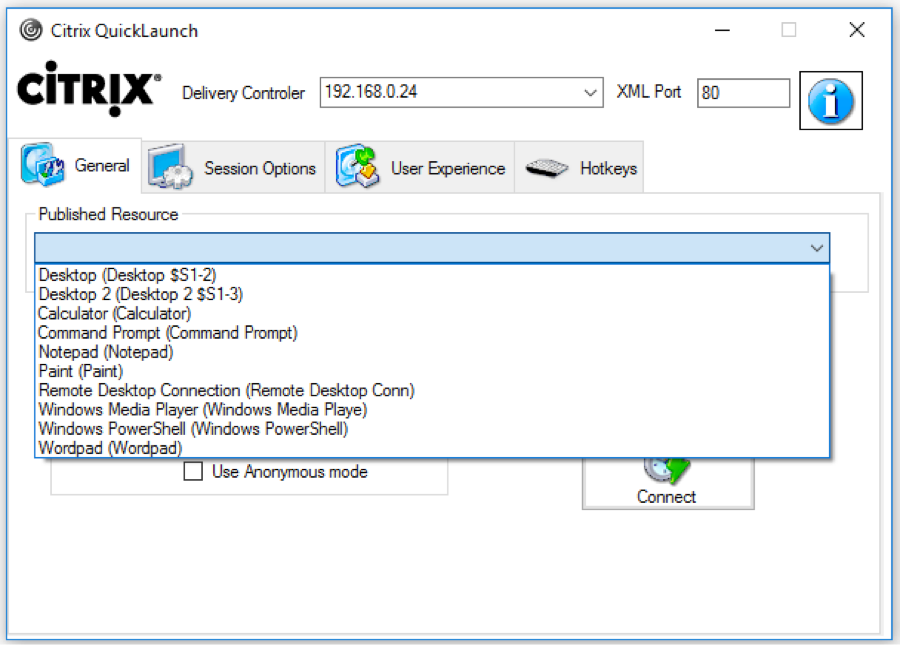
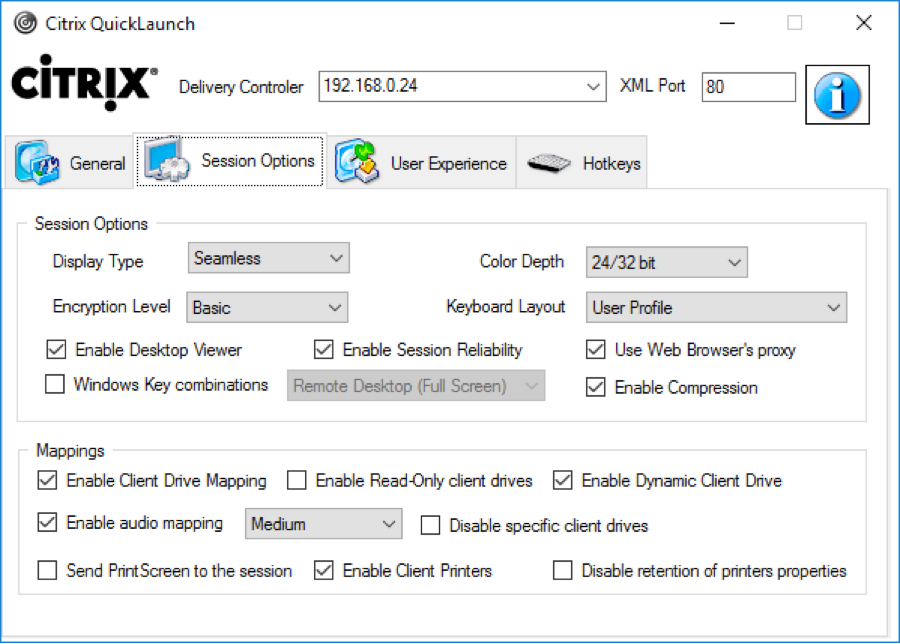
If you run into problems launching a session, use Sysinternals DebugView while running CQL in Debug mode (/debug switch).
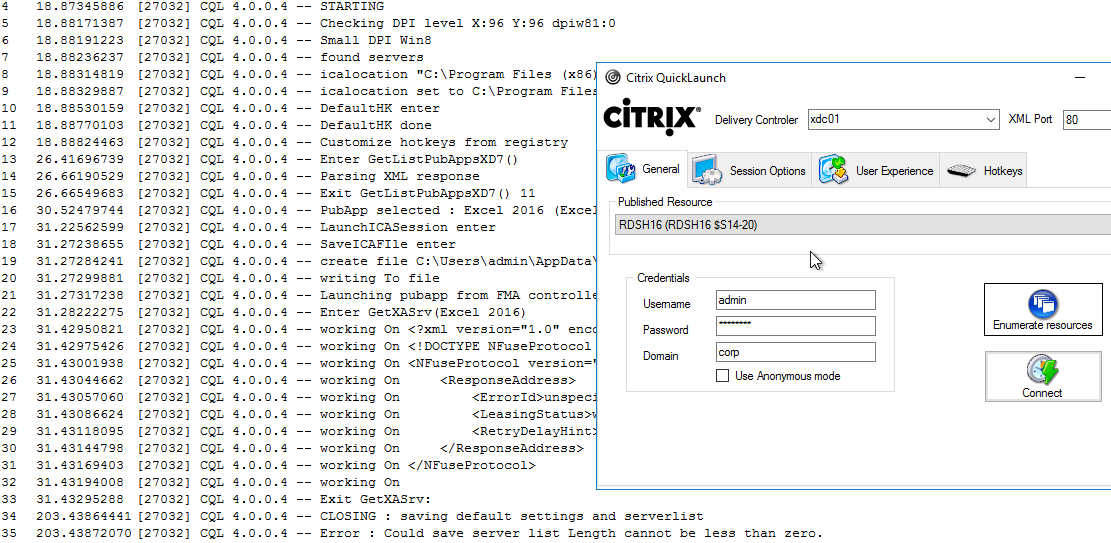
Troubleshooting – Workspace app Logging
In Workspace app 2309 and newer, if you right-click the Workspace app icon in the system tray, there’s a Troubleshooting menu with a Collect Logs option.

You can also access Log Collection from Advanced Preferences.

There are a couple methods of logging Workspace app for Windows operations. One method is CTX141751 Citrix Receiver Diagnostics Tool – For Windows, which creates a CDF trace that can be parsed by CDFControl.
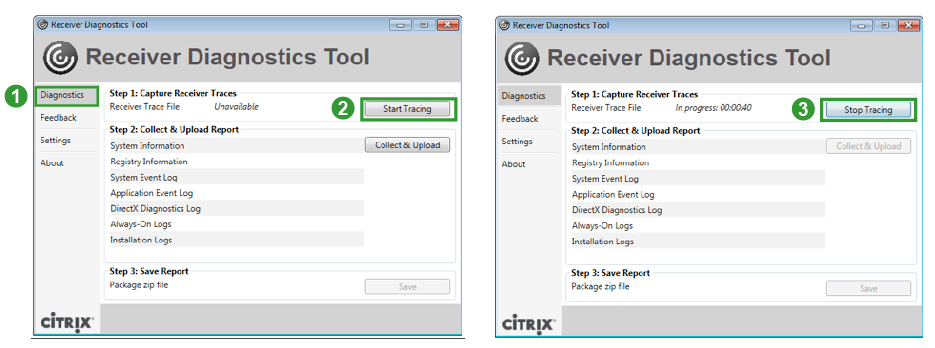
Another method is CTX132883 How to Enable Logging on Receiver for Windows Using Registry Entries. The logfiles in %USERPROFILE%\Appdata\Local\Citrix\ are human readable. And CTX206102 Enable SSON Logging Using Registry Key.
Instead of creating the registry keys manually, you can use the following .reg file provided by Wolfgang Thürr:
Windows Registry Editor Version 5.00 ;only for x64 windows os ;import with admin rights ;restart your computer to activate the logging and tracing settings ;create C:\TEMP for the launch ICA log and SSON logn (no environment variables can be used) ;general Workspace app and Receiver logging ;************************ ;logpath: %USERPROFILE%\Appdata\Local\Citrix\Receiver [HKEY_LOCAL_MACHINE\SOFTWARE\ Wow6432Node\Citrix] " ReceiverVerboseTracingEnabled" =dword:00000001 ;Authentication Manager logging ;***************************** * ;logpath: %USERPROFILE%\Appdata\Local\ Citrix\AuthManager [HKEY_LOCAL_MACHINE\SOFTWARE\ Wow6432Node\Citrix\ AuthManager] "LoggingMode"="verbose" "TracingEnabled"="True" "SDKTracingEnabled"="True" ;Self Service logging ;******************** ;logpath: %USERPROFILE%\Appdata\Local\ Citrix\SelfService [HKEY_LOCAL_MACHINE\SOFTWARE\ Wow6432Node\Citrix\Dazzle] "Tracing"="True" "AuxTracing"="True" "DefaultTracingConfiguration"= "global all –detail" ;save launch ICA ;*************** ;logpath: C:\TEMP\ica.log (no environemnt variables allowed) [HKEY_LOCAL_MACHINE\SOFTWARE\ Wow6432Node\Citrix\ICA Client\Engine\Configuration\ Advanced\Modules\Logging] "LogConfigurationAccess"=" true" "LogConnectionAuthorisation"=" true" "LogEvidence"="true" "LogICAFile"="true" "LogFile"="C:\\TEMP\\ica.log" "LogStartup"="true" ;Receiver Always On Tracing ;************************** ;generates ETL Files for analyzing with CDFControl see CTX111961 for details ;can be configured or overruled by GPOs (icaclient.admx) ;path %USERPROFILE%\AppData\Local\ Temp\CTXReceiverLogs [HKEY_LOCAL_MACHINE\SOFTWARE\ Policies\Citrix\ICA Client\AoLog] "EnableTracing"=dword:00000001 ;Single Sign-on Logging ;************************** ;https://support.citrix.com/article/CTX206102 [HKEY_LOCAL_MACHINE\SOFTWARE\Wow6432Node\Citrix\Install\SSON] "DebugEnabled"="true" "LogPath"="C:\\Temp"
Troubleshooting – Duplicate Stores
Stores are sometimes duplicated in Workspace app, especially if you are running Workspace app inside a VDA. (h/t Dan High)
StoreFront URLs can be defined in several places:
- In Studio, go to Configuration > StoreFront and delete all URLs configured here.
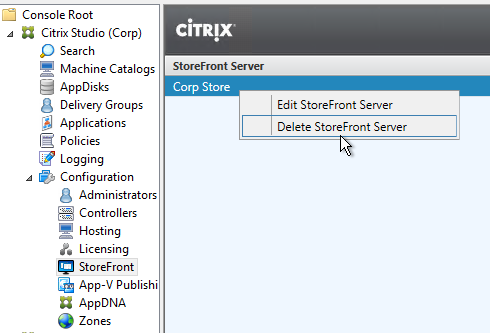
- Look in GPOs for Computer Configuration > Administrative Templates > Policies > Citrix Components > Citrix Workspace > StoreFront > NetScaler Gateway URL/StoreFront Accounts List. Remove any URLs configured here.
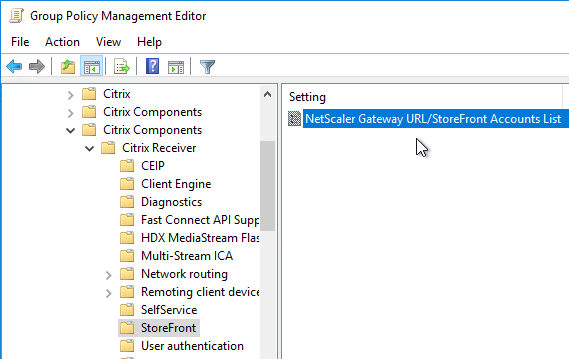
- In the client-side registry, at HKLM\Software\Wow6432Node\Citrix\Dazzle\Sites, you might see store addresses that were specified during a command line installation of Workspace app.

- When Citrix Workspace app switches between StoreFront servers in multiple datacenters, it’s possible for each datacenter to be treated as a separate Workspace app site. This can be prevented by doing the following. From Juan Zevallos at Citrix Discussions:
- Match the Base URL in all datacenters.
- Match the SRID in all datacenters – The SRID can be safely edited in the C:\inetpub\wwwroot\Citrix\Roaming\web.config. Make sure to propagate changes to other servers in the group.
- Match the Delivery Controller names under “Manage Delivery Controllers” – The XML brokers can be different, but the actual name of the Delivery Controller/Farm must be identical.
If you are running Workspace app on a VDA, once you’ve removed the configured URLs shown above, do the following to clean up the VDAs:
- On the VDA, HKEY_LOCAL_MACHINE\SOFTWARE\Policies\Citrix – Delete the number folders representing policy entries.
- On session host VDAs, HKEY_LOCAL_MACHINE\SOFTWARE\Wow6432Node\Microsoft\Windows NT\CurrentVersion\Terminal Server\Install\Software\Citrix – Remove the entries for storefront in the following folders.
- Under \receiver\ctxaccount delete all entries.
- Under \SR\Store delete the entries.
- On the VDA, C:\ProgramData\CitrixCseCache – Delete all files
- On the VDA, C:\ProgramData\Citrix\GroupPolicy – Delete all folders and files.
- Run gpupdate and logoff.
- In the user’s registry, HKEY_CURRENT_USER or the profile registry hive. Possible profile reset.
- Under Software\Citrix\Dazzle\Sites – Delete all entries.
- Under Software\Citrix\Receiver\ctxaccount – delete all entries.
- Under Software\Citrix\SR\Store – delete the entries.
- Verify no cached profile folders for user on server.
Had an issue with Receiver v4.10 where start menu and Desktop shortcuts were only displayed when the AllAppsAreMandatory reg value was set to true. You have any comments on this?
Did it work in 4.9?
Do you have Favorites enabled? If so, only Favorites are added to Start Menu and/or Desktop.
It seems the settings I had as hklm dazzle policy settings to enable start menu and desktop icons are not picked up by receiver 4.10. They were by receiver 4.6 which I had installed previously. Enabling the settings in hkcu works but not sure why the hklm policy not working
If you configure a StoreFront site to also use PNAgent services site, can you configure the authentication behaviour for the PNAgent differently from the Receiver for Web? Basically I want to be able to allow SSO for the PNAgent services site but prompt users to logon to the Receiver for Web site.
Thanks
Simon
I’m not sure – https://docs.citrix.com/en-us/storefront/3-5/advanced-configurations/sf-configure-pna-auth.html
hello,
after installing Receiver 4.10, i get the “Citrix Shell Support has stopped working” error message in my VDI. has anyone faced this issue yet?
an update: an event viewer log says MMVDHOST.EXE crashed
What client OS? What VDI OS? What VDA version? How are you connecting – internal, or NetScaler Gateway? Do you have Skype Optimization Pack installed?
OS:Windows 10 build 1703 same as VDI OS, VDA Version 7.14.1, we are connecting through NetScaler GW and we dont have Skype Optimization tool installed.
The error you’re seeing is on the client side?
If you revert to 4.9.1000, does the problem go away?
the error i am seeing on the VDI side, after a while session is established. it doesnt come up again but when we restart the VDI, it comes up again. we havent tried it with PVS.
sorry, in my last message i did not reply all the questions, with Receiver 4.9.0.2539 version, we dont have this situation.
Ok. You will probably need to open a support case.
Does this work if you connect using the same client machine directly (i.e., without NetScaler GW?) to the same vda machine with 4.10 citrix receiver?
we found out that when and if any webcam is installed, this problem occurs, we do not have this situation with the computers which dont have any cameras installed. if we disable camera from the device manager, problem doesnt occur. it is a very strange problem 🙂 Citrix suggested installing 7.16 version.
I would be interested in knowing how to only put shortcuts on desktop if the application (in studio) has the option checked, and nothing in the start menu. I’ve tried a ton of variations with dazzle settings to accomplish this, to no avail.
Hello carl, hello community,
i am very confused with a issue from our new customer:
following situation:
Fresh Installed:
– XenDesktop 7.15 LTSR
– Storefront – newest version
– Receiver 7.7 – 7.9 in use
We have 2 domains in a Forrest (1 Root + 1 Child Domain), all Citrix Infrastructure Components are located in the child Domain..
– SSON is configured for all Users in the Child Domain.
We have some virtual clients (win10) for testing purposes:
– one user cannot start the published Citrix Desktop
–> many Nested Groups
– the other users all can start the Citrix Desktop successfully
We have also physical Clients on a VPN connected Location.
– the User with the regarding Issue can start the Desktop without any Problems
Firewall Team means, that both Subnets have the same ACL.
The User was migrated from a another Environment (AD before Out-Sourcing of the Company was started)
Can this makes Problems?
My biggest Problem is actually at the troubleshooting.. i don’t get any Feedback from a Server or Eventlog at the Time, if the Starting of the Desktops gets failed.
Maybe Any Attributes from the migrated User? Any Idea?
Best Regards and looking forward to hear from anybody soon
Carl,
We’ve been searching for a way with Receiver 4.9.x to reproduce the historical/legacy behavior where if an application is disabled, but not hidden, the Start Menu/Desktop shortcuts remain available but simply generate errors stating the application is unavailable, even post-app refresh. With 4.9.x, the default behavior seems to be to remove the apps at next refresh interval. If you set the reg keys for SilentlyUninstallRemovedResources=false, then this doesn’t happen, but instead of the app unavailable error, the user gets a prompt if they want to remove the shortcut.
Any ideas on how to bypass the prompt and have it just generate an error? Thus far support hasn’t had any ideas.
Are you saying that Set-BrokerApplication with Enabled=$False but Visible=$True causes Receiver to remove the icon? Same behavior in Rfweb?
Please be aware that the current version of Citrix Receiver 4.9 LTSR has a bug. It will crash when you use the ALT+ENTER key combination in Microsoft Office Excel. This will be fixed in Citrix Receiver 4.9.1000, which will be released very soon.
The bug is in gfxrender.dll. Citrix Receiver 4.9.1000 will include a updated version of this DLL file.
Hi Carl,
just wondering if you ever answered this question ” if any configuration changes are performed that affect the Provisioning File, do the Receivers reconfigure themselves automatically?”. From what I can see if I make a change to the beacons – that is not reflected in the existing receiver configs – but of course new installs are ok. As we are using desktop lock, i’m not too sure how to change this….
Cheers
Dave
Hello
We need your help????
When we disconnect the client receiver the netscaler gateway disconnect to. Have you a solution for separate the both diconnection.
Thanks on advance
Best regards
Hi Carl, we’re having an issue where the desktop viewer toolbar is behaving inconsistently when the password enforced screensaver kicks in after 15mins on a Windows 10 VDI ? This is with receiver 4.4.4000 LTSR or 4.9 LTSR running on the end point. The toolbar appears to disappear into the background which makes unlocking the machine difficult. The scenario is recoverable if you switch to the running CDViewer process and resize the window however would not be possible as all of our thinclients run in full screen mode. This only occurs in full screen mode and not windowed. Appreciate any assistance ? Thanks.
Carl does Citrix receiver for Windows offer mfa yet?
Hi Carl !
Thank you for all you do for the Citrix community !
FYI for creating a ICA file
You mention a script on Github to generate an ICA file from Storefront, but I also notice you mentionned Citrix QuickLaunch 4.1 on your site as a debug tool for the receiver.
I was able to generate an ICA file from Citrix QuickLaunch tool, I use the tool to connect to a publish app on a DDC, then I monitor my %TEMP% folder for an ICA file genereted by this tool. Rename the file and edit the ICA file after
Make sure to remove this line:
RemoveICAFile=Yes
Hi Carl, Another question – We access VDI’s from an underlying windows OS . However when the user logs in to the underlying machine, the credentials are not passed through to the VDI if there is a password enforced screensaver running on the VDI itself. Is there a way for the credentials to pass through without removing the password enforced screensaver ? We want to prevent unauthorized access to VDI’s outside of ICA connections so need that screensaver in place. Many Thanks.
Having issues with Receiver populating the start menu automatically. I have to right click on Receiver and select refresh for it to begin configuring the store. I have InitialRefreshMin & Max set 1 which hasn’t helped.
Also having issues with session sharing, is this a known issue with Receiver 4.x?
Hi Carl, great content as usual. I’m having some difficulty in importing the citrixbase.admx and receiver.admx policy definitions. These have been copied into C:\windows\policy definitions however when i go to edit the GPO and import the template in, they are not visible. Is there anything further that needs to be carried out ? The delivery controller components are installed so i have visibility to the standard citrix policies via the GPMC. This is being carried out on a Windows 2012 Server O/S. Appreciate any info.
Are you doing local GPO (gpedit.msc) instead of domain GPO (gpmc.msc)?
Do you have PolicyDefinitions in your Sysvol folder?
Once you put the files in PolicyDefinitions, you do not need to add them manually to each GPO.
Hi Carl – thanks for quick response. Domain GPO is being carried out. Yes we are adding policy definitions to the sysvol folder so will get these added.
Hi Carl,
Currently we are testing with Xenapp 7.16. Can we still use Receiver 4.3 or are we forced to upgrade to 4.9?
Thanks
Nick
It should work with 4.3. But new functionality (e.g. EDT) is only in newer Receiver 4.9.
Carl, any possible way to set client selective trust for unmanaged non domain machines? or to protect at the connection center preferences for file access and connection for unmanaged devices?
Some Receiver settings can be delivered by StoreFront, but I don’t think Client Selective Trust is one of them. That would be a major security issue if you can tell remote Receivers to map client drives without any approval from the user or the user’s administrator.
It’s work.
Thank you for shared knowledge.
Hi Carl,
I am testing 4.9 receiver with SSON for Xen App is 6.5 farm. I was expecting when user logs to windows domain login the apps should display on the desktop/All programs by default but It’s not working on my test but Citrix support referring I need to open receiver and add to favourite to display. Is this correct behaviour for 4.9 receiver?
The current running version is 12.3.0.8 and apps are showing in desktop/all program once user logged in.
Thanks,
Visa
You can either turn off Favorites (StoreFront console > disable user subscriptions, mandatory store), disable Self Service (Receiver group policy), or add keywords to your published apps so they are automatically added as favorites.
Excellent Carl by disabling the Self Service (GPO) it worked for me. Many thanks
Carl do you know if this was fixed in 4.8?
Citrix receiver continually prompting for password (external access)
I have some users starting to complain about this.
I can set the..
64-bit Windows Location: HKLM\Software\Wow6432Node\Citrix\Dazzle
Name: RefreshMs
But I was hoping It would be fixed in 4.8. I don’t see it in the Fixed notes.
Do you know by chance?
Carl,
You do such a great job providing us in the citrix realm with such detailed and amazing information. We appreciate all you do. I pray for continued blessing for you and all your skills for your blessings to us. OK.. here is my scenario I would like to get your guidance on. My company is doing a migration from 6.5 and setting up a new 7.13 environment. The task I been given is to see how to properly upgrade the citrix receiver they using, version 3.4 which is using TLS 1.0 and move it over to a newer version like 4.5 or higher on TLS 1.2 and be able to turn off TLS 1.0 and not have to downgrade or turn on TLS 1.0 on the new netscaler. What are your thoughts and ideas here? How should I approach this? Never dealt with the TLS protocols myself, so this is new to me.
Thank you!
RS
Ideally you would have new DNS names for StoreFront. Then deploy the Receiver with a new GPO that specifies the new DNS names. These DNS names point to NetScaler SSL vServers (Gateway and Load Balancing) that have TLS 1.0 disabled.
So, that is if they decide to turn tls 1.0 off, but if they dont turn it off then just simply update the receiver and be done since both are on right? Or will there still be something needed done on the gpo policy, or netscaler storefront sides?
Carl,
My company wants to go to 7.13, but they want to not move away from receiver 3.4 for several more months, is this possible? Isn’t there a minimum requirement for 7.13 on receiver or will 3.4 work still? What would be some of the major issues we could encounter by doing this? I saw some articles on how newer receivers upgrade your HDX etc but I could not find something saying it was necessary to move from 3.4 etc because it will break.
Ruben
Hi Carl,
We had a bug with Receiver 4.8, doing Alt+Enter in a seamless session on Windows 2012R2 or Windows 2016 crashes the Receiver and we had to reconnect to the session. Sometimes, the application window the black but most of the time Receiver crash.
Alt-Enter is use in Excel to add a line break in a cell.
We don’t have this bug when we use a seamless session on Windows 2008R2.
Receiver 4.7 works fine with all version.
Any hints?
Thanks
Carl do you know if this was fixed in 4.8?
Citrix receiver continually prompting for password (external access)
I have some users starting to complain about this.
I can set the..
64-bit Windows Location: HKLM\Software\Wow6432Node\Citrix\Dazzle
Name: RefreshMs
But I was hoping It would be fixed in 4.8. I don’t see it in the Fixed notes.
Do you know by chance?
We are facing the same problem!
Did some one has more informations about this problem?
Thanks in advanced
Tim
“Unfortunately, there’s no configuration option in NetScaler Gateway to force a particular store.”
Is this still the case? It is a big issue for us.
Regards
Martin
Apologies if this was covered elsewhere. In XA 6.5 we could publish a single app to live in the Startup folder and up through Receiver 3.4, the action would process properly. With Receiver 4.x the SelfService app no longer appears to recognize this setting whether connecting to our legacy NSG, or through Storefront (6.5 or 7.13). Can this still be done in Receiver 4.x? We obviously don’t want to make Startup the default folder for all published apps.
Interesting. I haven’t ever thought of trying that. I could see that being useful for some applications so the user doesn’t have to launch it. I personally would need to play around with it, but wondering if WEM could help with that if it no longer works through Receiver. We have it place shortcuts for users based on their clientname and automatically launch them.
Use https://support.citrix.com/article/CTX200337 to script published icon launches from Receiver.
Yeah, we are doing that as a workaround via GPO, although we are using -qlaunch instead of-launch as the syntax is simpler. Was monumentally easier before (Just a checkbox) because the Citrix team didn’t have to sync with the desktop team to modify GPOs during frequent app upgrades. Ah well…. Job security.
Carl–Thanks for all the time you spend educating all of us! : ) I don’t have a problem that I need help with–I’m just trying to better understand how the native Receiver works in a StoreFront deployment where NetScaler is involved.
In the section of this post where you describe what happens after Receiver is configured–the section that begins with “Once Receiver is configured, it then performs the following steps:” All of what you describe here makes sense to me in the scenario you’ve laid out where the NetScaler gateway address is different than the StoreFront base URL–i.e. a dual FQDN configuration.
What I’m having a difficult time finding a clear explanation for is how this process works in a single FQDN deployment where the NetScaler Gateway address and the StoreFront base URL are the same and where the internal beacon is a different DNS name that points to the StoreFront load balancer VIP. It seems the process would have to be different for a single FQDN configuration. Otherwise, the Receiver would connect to the same address (StoreFront Base URL which is also the NetScaler Gateway address) whether the internal beacon is reachable or not. Would you mind explaining how this process works in a single FQDN configuration? Hopefully I’m not the only one with this question! Thanks!
The process is the same. If Internal Beacon is reachable, then the Single FQDN better resolve to StoreFront because Receiver will assume it is NOT NetScaler Gateway and behave differently. Unfortunately, Receiver is not smart enough to query the destination to determine if it is a Gateway or not, and instead uses the Internal beacon to make that determination.
HI Carl,
So I ‘ve been working on adding shared application shortcuts according to this documentation and Citrix’s. I’ve also called support to troubleshoot (no help). Bascially I can enter a store front server manually when prompted by the Receiver (4.8), but can not pre-configure this using the Group Policies as documented (Store Accounts List). I’m wondering what is the requirement of the /discovery in the path, and how would I configure my existing storefront to make use of it? I can not find an interface to modify my StoreFront. I also attempted to create a new storefront but there was no option to alter the URL to include /discovery. I am using the latest GP template for Receiver. I’ve used the Receiver cleanup tool on my master and reinstalled the Receiver with SSON enabled. Using MCS..
Thanks
Kevin
Hi Carl,
I’m installing Receiver 4.6 using a CLI as follows:
“CitrixReceiver.exe” /silent /ALLOWADDSTORE=A /SELFSERVICEMODE=False STORE0=”domainstore;http://citrix.domain.net.au”
The problem I’m getting is that when a user logs onto the machine, there’s no prompt for them to log on to the Citrix environment. The server is in a different domain, so I believe SSO isn’t an option. Any ideas?
Cheers.
Hi Carl,
I am using Receiver inside non-persistent VDI and the problem is that the store configured to the GPO is not coming into use. Instead there’s another store when I check the Receiver -> Accounts. I think your guide about duplicate stores will help, but before I do anything I’d like ask what is the purpose of the Citrix Studio -> Configuration -> StoreFront setting, which you suggest should be deleted? What is that setting for, and what will happen if I delete it?
It’s entire purpose is to inject the Store address into a Receiver that is running on the VDA. I personally prefer to use group policy instead of the StoreFront node in Studio.
Another great article Carl. I was hoping that you could give me a little help. We are rolling out a new XenApp 7.13 environment, including upgrading all the the latest receiver, 4.8 with SSON. Everything has gone smooth but I have a couple users once I have install the new receiver with SSON when I go to add the store I keep getting “Your account cannot be added using this server address.” They are setup exactly the same. Could some kind of corruption on the PC break this as hardware is the only thing that is different then some of the others. I know that isn’t a lot to go by and can provide more details but this has me stumped.
The address is https?
Same FQDN for Gateway and StoreFront?
Beacons are configured correctly? Internal beacon only works internally?
yes sir..it only does this for this one user, but I think I have narrowed down the issue. I can actually setup the user on another computer and it works fine. I am rebuilding their Windows Profile to see if something is just corrupted within her profile.
New windows profile fixed the problem..
Hello Carl,
our Citrix Receiver GPO deployement script is working as accepted with Citrix receiver version 4.7.
We just have a small problem with the SSO settings:
It is possible to get the SSO settings up and running without a “log off” and “on again” from the client?
If not how can we disable to popup windows where the user should enter the credentials?
Thanks
Tim
ssonsvr.exe hooks into the Winlogon process. So a Winlogon has to occur for ssonsvr.exe to capture the user credentials.
alright thanks for the fast feedback :).
… it is possible or do you have a solution to block the popup where the users should enter their credentials?
Thanks
Tim
I am seeing inside of connection center Devices are greyed out. I never seen this before. In my previous deployments. once I enable USB redirection to allowed its works.
Anybody seen this?
Never Mind, Its my lab.
Carl,
Under the section, “Pass-through Authentication”, we have XenApp 6.5 HRP7 and the Delivery Controller/Storefront server has IIS, so XML uses port 80, without messing with port 80, what is trick? Does the PowerShell command you reference needed for 6.5? If so, it won’t run, guessing I’m missing module.
My goal(s);
1. are to allow Storefront 3.9.0.56 to allows SSO from my laptop all the way into the Published Desktop. All that is working now, but if WorkSpace Control is enabled, the “Logoff action” function fails because of the Trust not working.
2. Use HTML5 Receiver, but since above is foo-barred, not able to launch, says see CTX134123
We do not have Netscaler, just LAN folks.
Thanks.
For 6.5, there’s a Citrix Policy that enables Trust XML. It’s not PowerShell.
Hi Carl,
thanks for the nice blog.
GPO for setting up the Storefront (Computer Configuration > Administrative Templates > Policies > Citrix Components > Citrix Receiver > StoreFront) ist not working on a fresh install on Windows 10 1703. Receiver 4.5-4.7 with current receiver.admx. Can anyone confirm this? I think it’s a MS Bug…
regards,
Andi
What exactly is not working? I just tried Receiver 4.7 on Windows 10 1703 and deploy StoreFront URL using GPO. Works great.
What do you see in HKEY_LOCAL_MACHINE\SOFTWARE\Policies\Citrix\Receiver\Sites?
the entries in HKLM were written, but they never will be imported in HKCU\Software\Citrix\Receiver\. The “Add Account Wizard” always shown on
we did customize the install.wim with ntlite (disable built-in apps, Import cumulative update and so on). One of the Image could had a failure
After we recreated the install.wim from scratch, it works well too, sorry…
have Attention, when working with such Tools 🙂
Hi Carl,
Thanks for another great article!
I’m working on the section of disabling the download and ‘switch apps’ prompts inside Edge. I’ve made the storefront config changes and propagated which forced Edge to change its prompt to ‘switch apps’ however now when testing the local registry change the prompt actually reverts back to the original download prompt. Has anyone been able to get this to work with Receiver 4.5 and Storefront 3.6 ?
cheers,
Dean
Hi Carl,
We are having issues with session roaming that does not automatically roam when we do Winlogon and Open.It does on Refresh and Launch. We have enabled all four options and self service is disabled. We have been with Citrix support for a few days and it seems it is a known issue but rt now nothing that Citrix has suggested has worked. Any ideas? Receiver is 4.5 and Xenapp edition is 7.8.
Regards,
Satish.
how do you prevent the eula message prompt for a pre launch session?
You mean the Windows security message? You could configure a GPO for your VDAs that disables the Windows logon message.
Hi Carl,
Thanks a lot for this however, I have a query here.. Under section “Device Access Behavior (Client Selective Trust)”, my users who are on Windows 10 don’t get an option of “Don’t ask me again for this site” option at all. What could be the issue? They are using Receiver 4.6
Hi Carl,
Thanks for a gerat post!
I have followed every single guide out there in order to enable full SSO for Citrix Receiver. It works great when you fire up a computer inside our organization, but as soon as you bring your laptop outside our company network and try to connect thought NetScaler, SSO is not working at all and Citrix Receiver asks for your password. And it keep doing so every hour.
Any idé where to look?
Thanks!
Citrix says that not supporting SSON through Gateway protects you from security issues. If you want this feature, please call Citrix Support and submit an enhancement request.
Ah, it was easy as that. Thanks!
Let’s just say that you’re not the first to ask for this. 🙂 But if more people ask, then maybe Citrix will find a solution.
you rock Carl
I think this link is broken “Full list of Citrix Client Uninstall Strings”
should probly point to http://euc.consulting/blog/full-list-of-citrix-client-uninstall-strings/
Thanks. Looks like he moved it again.
Hi Carl…
I installed Citrix receiver with a script…problem is that i can only seem to get my script to properly deploy clients to connect to my delivery controller via the internal fqdn but if i setup manually it works correctly.
Here is what I did to deploy the receiver the first time.
citrixreceiverweb.exe /ALLOWADDSTORE=A /includeSSON /STORE0=”CompanyStore;https://xenapp7.domain.company.com/Citrix/CompanyStore/PNAgent/config.xml;on;CompanyStore”
Here is what i am trying to do but is not working:
citrixreceiverweb.exe /ALLOWADDSTORE=A /includeSSON /STORE0=”CompanyStore;https://xenapp7.company.com/Citrix/CompanyStore/PNAgent/config.xml;on;CompanytStore”
https://xenapp7.domain.company.com is the internal fqdn.
https://xenapp7.company.com is the external fqdn and it does work if i setup the receiver manually.
As well, i would prefer not to have to uninstall but instead just update the config. Last but not least i would also like to enable single sign on.
If you could provide some expert guidance so i dont have to roll out 150 of these manually, I would be extremely grateful. I am a very big fan and have learned a lot from your site.
BTW…we use N-Able to manage our environment and will be deploying this via a batch file.
Receiver does not support specifying a Gateway discovery address from the command line. I have no idea why this doesn’t work.
You could set the HKLM registry key instead.
Hi Carl,
I’m on installing as a demo of new Citrix XenApp 7.9 with 01 Delivery Controller, 01 Store Front, 01 License Server and 01 XenApp Server.
License Server : OK
Delivery Controller: OK with basic configured
Storefront: Follow your instruction with SSL.
– In Manage Delivery Controller section with 1 DC above and HTTP transport type.
– In Manage Authentication section also checked Domain pass-though
But when i add server address with Receiver 4.5, it didnt accept 🙁 Link just like: https://storefront.corp.domain/Citrix/Site/discovery . I’m also switched between default internal beacon and specified beacon but still the same result.
So i’m stuck in that and need your help for my configuration.
Thank Carl!
Is the certificate trusted? If signed by an intermediate, is the intermediate installed and linked on the NetScaler?
IIs it possible to preconfigure all the icons on Citrix Receiver 4.x (4.6 actualy) with SelfService Mode = True ?
Are you asking if you can auto-subscribe the icons? Put KEYWORDS:Auto or KEYWORDS:Mandatory in the published app description.
Yes, i talking about auto-subscribe, but this feature works only with Storefront, no ? Actualy, we have XenApp6.5 with WI5.4
I just tested it with Storefront 3.8, it works … But it’s a real graphic revolution for users :p
Thanks for your help !
Hi Carl,
We recently moved a few users from our accounting department to our Citrix VDI (XenApp/XenDesktop v7.8) environment and they are having an issue with the Federal Reserve or FedLine USB security token not passing-thru from their Dell Wyse client device. I checked that USB redirection is enabled and its working fine for our USB yubikey that we used internally as 2 factor authentication so I’m not sure what could be causing the issue. We also updated the thin client firmware and confirmed that the model of token is supported under the full thin client OS. As a test I have the user connect to their provisioned virtual PC from a laptop with Citrix Receiver and it works fine. Any thoughts or suggestions?
If the problem only occurs on Wyse, then I assume Wyse is the vendor you’ll need to contact. I haven’t needed to troubleshoot this anywhere so I don’t have a solution for you. You can try posting your question to http://discussions.citrix.com.
Hi Carl,
I have been at google trying to solve this problem
At my Master image – deployed with MCS.
Unsure why or how this error occured – I have Xenapp running 7.12, with receiver 4.6.
The Single Sing-on process is not running. Reboot the machine after installing Receiver to start the process
– Which is the error message you have at your example.
I have restarted the machine – with no changes 🙂
Also tried to manipulate the NetworkProviderOrder in reg – to remove entries, and put pnsson infront.
Rest of the configuration checker gives green checkmarks.
But for some reason ssonsvr.exe is not starting – any suggestions in what to do, and how to proceed?
The GPO is configured?
Yes – I do believe they are configured correct.
Test Provider SSOnChecker.dll – Blue informational mark.
Installed with Single Sign-on Green
Logon credenditial Capture – Green
Network Provider registration – Green
Single Sign-on process runng – Red
Group Policy – Green
Storefront store configuration – Green (internet settings for storefront URL)
Storefront store configuration – Green (Auth methods for the website).
I have tried to remove the Citrx receiver with and without the removal tool and installed it again.
No security software getting in the way? Does it work on a clean image?
Well – it was working at my other images.
Have made it work, without figuring out the cause.
I reverted to my “old snapshot” before the SSON started failing, did the same installations again, and this time everything is working.
Might be related to my upgrade from receiver 4.5 to 4.6 or VDA 7.11 to 7.12.
(Also installed Google Chrome, but really cannot see how that would change anything)
Thanks for your suggestions anyway, and keep up the excellent work you are doing with this blog.
For all of you who suffer from the Published Application & Roaming profile problem.
With the new Citrix Receiver LTSR 4.4.3000 Citrix solved the problem. For us it worked. Without roaming the usrclass.dat.
https://www.citrix.com/downloads/citrix-receiver/windows-ltsr/receiver-for-windows-ltsr_4_4_3000.html
Fixed issue:
File type association might not work when logging on using a roaming user profile and opening an published application.
Hope this helps.
Hi Carl,
We have two-factor authentication (primary password and secondary RSA token) implemented on out XD site.
We have been able to customise the login screen at Netscaler level to override the default “Password 1” and “Password 2” prompt.
However, on Receiver, we still see the labels “Password 1” and “Password 2”
Any hint on how to customise that?
Thanks
Receiver should say Password and Passcode. I don’t think it’s possible to change the Receiver labels at this time.
Hi Carl,
Thanks for helping the community with your blog:)
From experience regarding Receiver reconnects/refresh etc.
One issue with the default Receiver settings when installing receiver.
WSCReconnectMode is default 3 (reconnect on launch or refresh) which is often prefered.
RefreshMS is default 1 hour.
In default settings scenario this can give problem for user, if for instance:
1.The user sits at his/hers workstation connected to citrix session.
2.The user goes to a meeting, to present something, leaves workstation, leaving workstation logged on, with session open.
3.User connects to session from meetingroom computer to present whatever.
4.The meeting lasts longer than 1 hour.
5.RefreshMS kicks in on the users workstation, results in the session from the meeting room beeing pulled back to the logged on workstation.
6.User angry, meeting disrupted.
One solution is to set RefreshMS to a bigger value, or set WSCReconnectMode to 0,1,4 or 8. But this again is not ideal from a user perspective.
Also, if Setting RefreshMS to 0, user can no longer double-click receiver icon from systray to open receiver window. Insted Advanced prefrences comes up.
This because setting RefreshMS to 0 removes the option to “Open” receiver when right-clicking the receiver icon in systray.
I wish Citrix could add WSCRecconect combination of 1 and 8:)
How can that be of the user is working in the current seasion in the meeting? The seasion will roam with the user.
There is a new version of Citrix Receiver for Android that was released. I had a case open and tested it for a while. It fixes the Session Reliability bug with Android version 3.9.2. With 3.9.2 you had to disable session Reliability with in Storefront under Manager Netscaler Gateway, Secure Ticket Authority.
This is the fix for me.
https://www.citrix.com/downloads/citrix-receiver/android/receiver-for-android.html
Hi Carl,
I was wondering if you have any input. I just created a second Delivery group with the same settings but it is on 7.9 instead of 7.6. When a non-admin logs in the apps are not publishing to the desktop and I dont see the log off button in receiver. When an admin logs in it puts all applications and published desktops on the desktop. I had it setup for hiding the desktop icons but they are still showing. Any ideas on why its not working on 7.9?
I think I answered my own question. /discovery is needed at the end of the URL. It does not show as part of the StoreFront’s URL in Studio. Apparently some special directive that Recevier picks up on?
I think I have it working.. Only two extra days pounding on it.
Thanks
Kevin